Today post is all about the challenges in my repo “angr-note”. I’ve written down my thought process and explained things step by step, so it’s easier to understand how I solved each one. Hope it helps you get more comfortable with angr :D
Below is the link to my “angr-note” Github Repo for installation, sources and solutions.
Reverse Engineering 101
Analyze the Binary
When loading the binary into IDA, you can notice that the program is really short.

Let’s examine the _start function. You will see that it is loading a bunch of hex values (which are actually ASCII characters) into a variable called _edata.
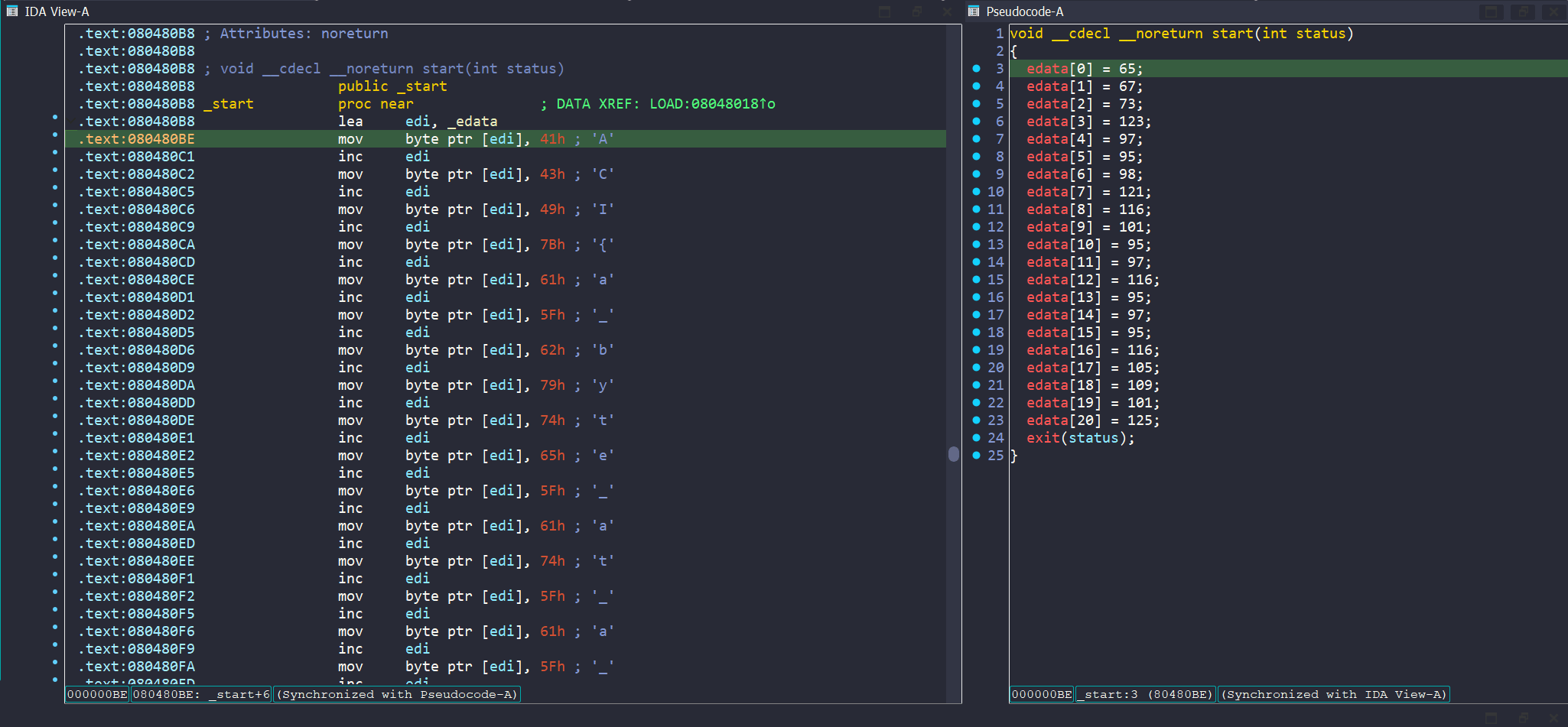
So, in the context of angr, if we can somehow make it have a step over the _start function, we should have the flag stored in _edata. Our job is to read it and get the flag!
Build the script
First of all, let’s include all the libraries, turn on INFO logging so we can see what is happening while the script runs, and the IPython debugging view. Personally, I love using IPython debugging view because it lets me quickly test things on the binary before writing out the full angr script!
import angr
import logging
logging.getLogger("angr").setLevel(logging.INFO)
def hook(l=None):
if l:
locals().update(l)
import IPython
IPython.embed(banner1='', exit_msg='', confirm_exit=False)
exit(0)Now, we should load the binary into angr and pick a place where our script should start. In this challenge, it’s best to start from scratch, as we want to have the _edata variable prepared. This means the binary loaded into our angr will prepare the _edata variable for us. If we start from somewhere else, we must create a symbolic variable for _edata, which makes things more complicated.
proj = angr.Project("./RE101")
init_state = proj.factory.entry_state()With IPython, we can test to see if our script is running properly.

Our goal here is to read the flag from _edata, and we can do that just by stepping through the _start function once. To do that, we use a Simulation Manager.
But why we need Simulation Manager while we can call .step() in init_state?
The answer is simple, when we use a Simulation Manager, calling .step() actually moves the program into the next state.
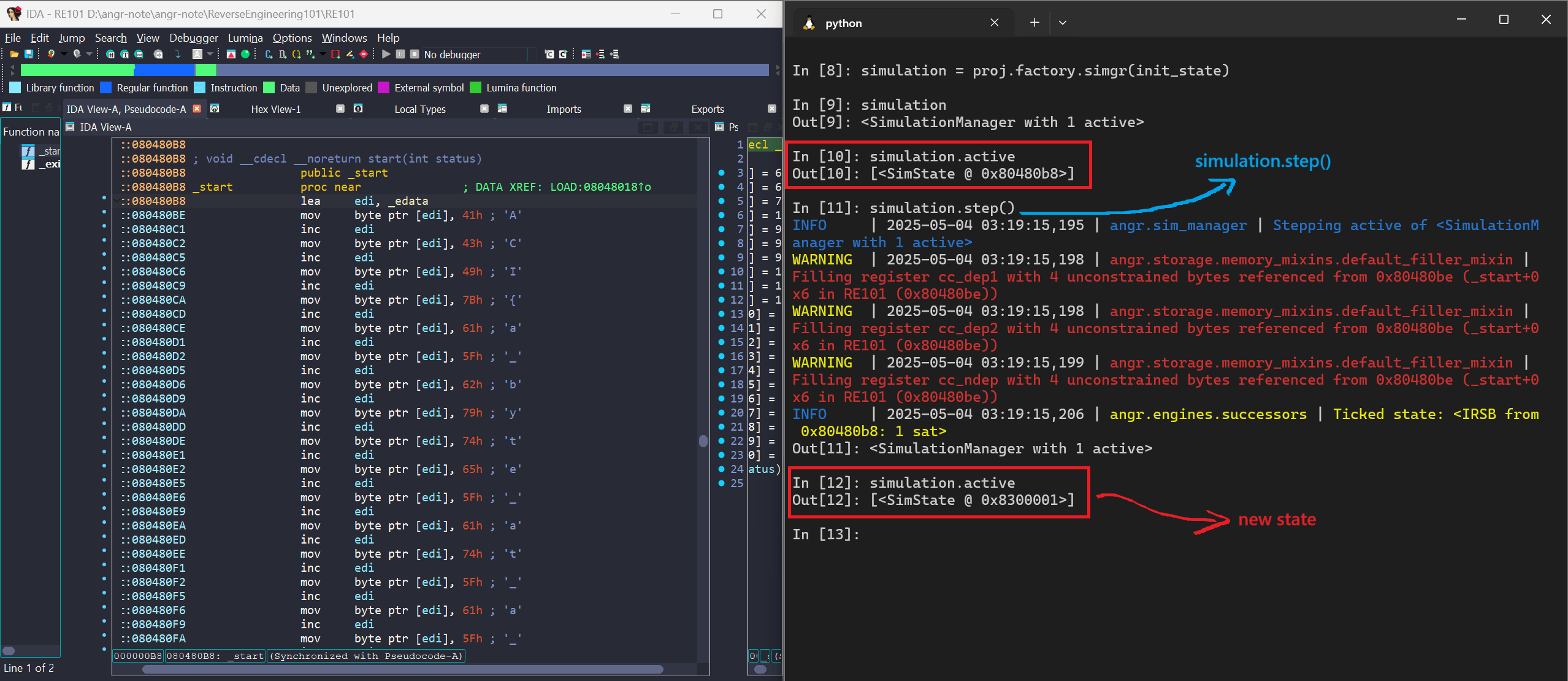
On the other hand, if we just call .step() on init_state, it doesn’t move forward, it just shows what the next possible state would be.

After making a step with Simulation Manager, we must find the address of _edata in the binary and then read the value at that address.
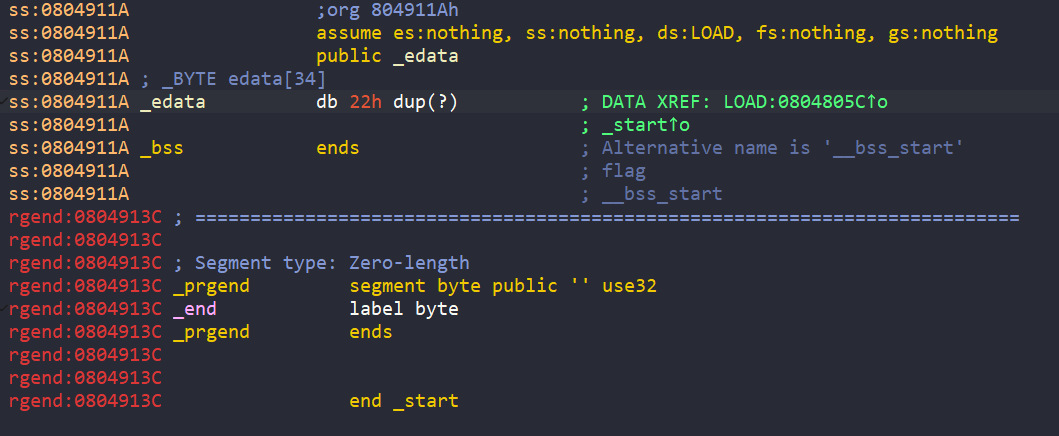

Solution
RE101 Final Script
import angr
import logging
logging.getLogger("angr").setLevel(logging.INFO)
def hook(l=None):
if l:
locals().update(l)
import IPython
IPython.embed(banner1='', exit_msg='', confirm_exit=False)
exit(0)
def main():
proj = angr.Project("./RE101")
init_state = proj.factory.entry_state()
simulation = proj.factory.simgr(init_state)
simulation.step()
flag = simulation.active[0]
edata_addr = 0x0804911A
print("Flag:", flag.mem[edata_addr].string.concrete)
if __name__=="__main__":
main()Library Card
Analyze the Binary
There is a function named print_flag from IDA.

As the name suggests, this function prints the flag. We can clearly see it calling printf, and the format looks just like a real flag!
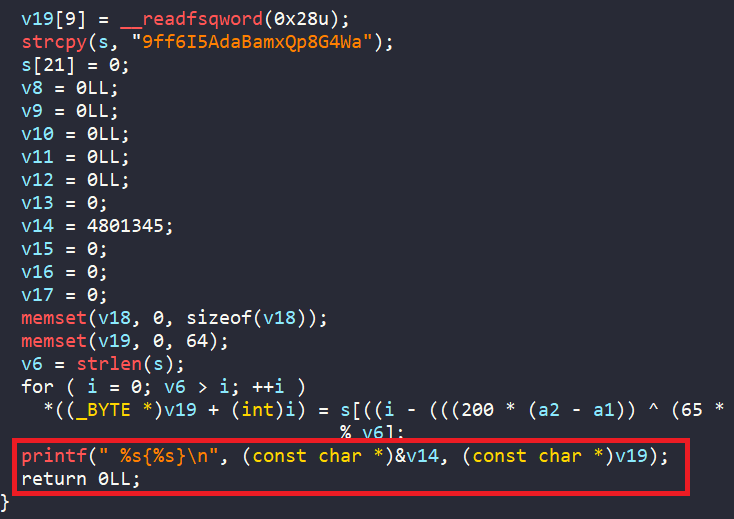
Let’s see which functions call print_flag using Xrefs to in IDA.
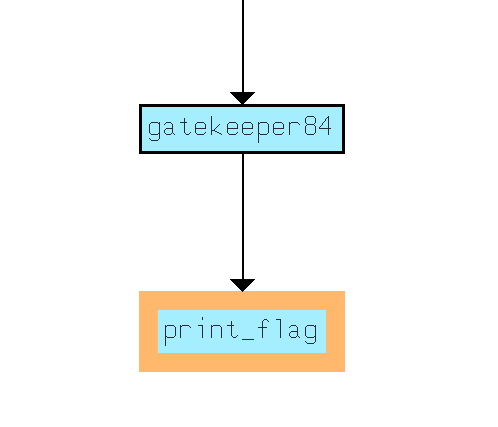
This is the pseudo-code of gatekeeper84.

So, with arguments in the picture above, we will have our flag. Furthermore, we can simulate this function call in angr using a callable function.
Build the script
We start with necessary libraries, LOGGING INFO view, and IPython debugging view.
import angr
import logging
logging.getLogger('angr').setLevel(logging.INFO)
def hook(l=None):
if l:
locals().update(l)
import IPython
IPython.embed(banner1='', exit_msg='', confirm_exit=False)
exit(0)Next, let’s load the binary into angr and do a quick check to make sure everything loaded properly.
proj = angr.Project("./liblibrary_card.so")
hook(locals()) # Open IPython debugging view
Now, we want to simulate the call of print_flag function. But as you know, to get a successful call, we must have the following info:
- Address of
print_flag - Arguments
To get the address of print_flag, we use the following comnand:
print_flag_addr = proj.loader.find_symbol("print_flag").rebased_addrNext, we use the callable function feature in angr, and pass the arguments 2084, 0x82C, 2091.
print_flag = proj.factory.callable(print_flag_addr)
print_flag(2084, 0x82C, 2091)Now, we should have a success print_flag call now. To get the result from the function call, we use result_state. Because this function prints the output to the terminal, or stdout, we must use the option posix in angr to get the stdout.

But why we don’t get the flag? This is because in angr, at this moment, the return value from function call is now a symbolic value. We can use the option .concretize() to force angr to give us the correct value (concrete value).

Solution
Library Card Final Script
import angr
import logging
logging.getLogger('angr').setLevel(logging.INFO)
def hook(l=None):
if l:
locals().update(l)
import IPython
IPython.embed(banner1='', exit_msg='', confirm_exit=False)
exit(0)
def main():
proj = angr.Project("./liblibrary_card.so")
print_flag_addr = proj.loader.find_symbol("print_flag").rebased_addr
print_flag = proj.factory.callable(print_flag_addr)
print_flag(2084, 0x82C, 2091)
if not print_flag:
print("print_flag function not found")
hook(locals())
flag = print_flag.result_state.posix.stdout
print("Flag:", flag.concretize())
if __name__=="__main__":
main()Read It And Weep
Analyze the Binary
Initially, reading the pseudo-code of main from IDA, there is an Buffer Overflow where the program reads 64 bytes from stdin into variable s, but s is a 16-byte array.
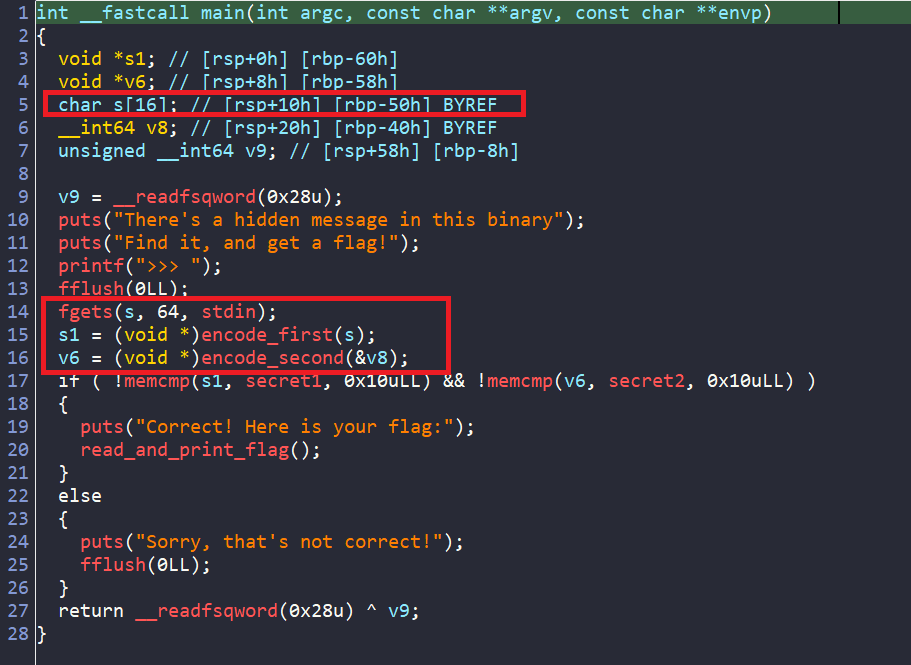
But look closely, s (an array) is located at rbp-0x50 and v8 (a variable) is at rbp-0x40. That is exactly 16 bytes difference, which is the size of s. I think this is a misinterpretion in IDA decompiler.
To fix this and avoid confusion later (especially since I will be creating a symbolic variable for the input), I resized s in IDA so things work properly.


And we have our new main.
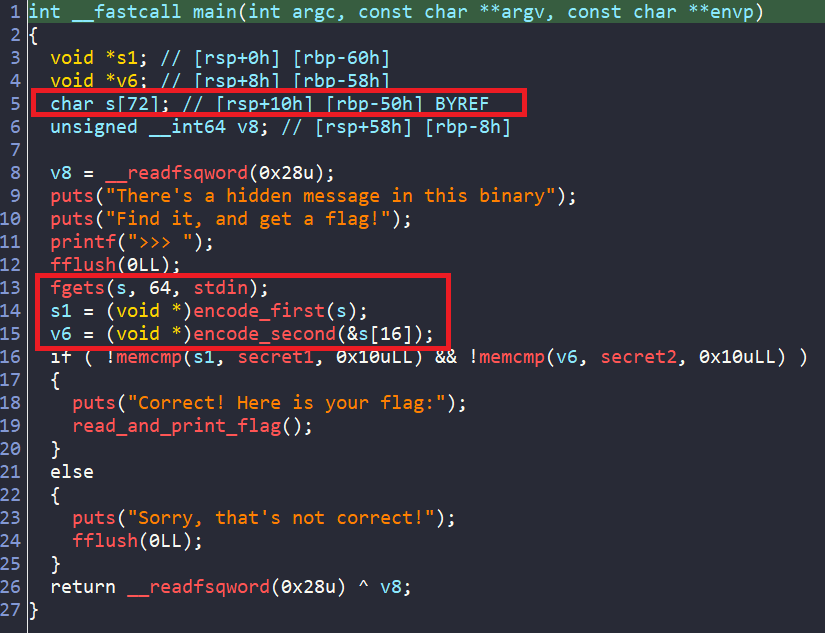
From the new main, the flow of our program is pretty straightforward:
- It reads input from the user
- Then, it splits that input and runs two different encoding functions for each half
- Finally, it compares the results with
secret1andsecret2
There is also a function named read_and_print_flag() at the success branch, where it prints data from the file flag. This is obviously our flag!
However, since I don’t have the raw flag file, so I just create one with data as below.

Now, for the angr script, what should we do?
Our goal is to get the correct input. That input will be a symbolic variable. We’ll let angr figure out the math, branching, and logic behind the scenes. Then, once angr reaches the success path (where read_and_print_flag() is called), we can simply concretize the symbolic variable to get the real input value that leads to the flag.
Build the script
We start with necessary libraries, LOGGING INFO view, and IPython debugging view.
import angr
import logging
import sys
import claripy
import string
logging.getLogger('angr').setLevel(logging.INFO)
def hook(l=None):
if l:
locals().update(l)
import IPython
IPython.embed(banner1='', exit_msg='', confirm_exit=False)
exit(0)Next, let’s load the binary into angr and do a quick check to make sure everything loaded properly.
proj = angr.Project("./read_it")
hook(locals()) # Open IPython debugging view
We will then create our symbolic variable for input from claripy library, with our custom size. Since the input asks for 64 bytes, we should create one with that exact size.

user_data_in_bytes = 64
user_data = claripy.BVS("user_data", user_data_in_bytes*8)
init_state = proj.factory.entry_state(stdin=user_data)Furthermore, we need to make sure our input only contains printable characters.
By forcing angr to use characters within the printable range, we reduce the number of states it needs to explore, which helps speed up the solving process.
It also ensures that the final input is clean and usable, that we can easily copy and paste into the actual program without any issues.
for i in range(user_data_in_bytes):
init_state.solver.add(
claripy.Or(*(
user_data.get_byte(i) == x
for x in string.printable.encode('utf-8')
))
)Now, we should find the path (success path) for angr. We could let the success path as the string “Correct! Here is your flag:”, and avoid the path to “Sorry, that’s not correct!” (speed up purpose only).

def success_message(state):
return b"Correct! Here is your flag:" in state.posix.dumps(sys.stdout.fileno())
def failure_message(state):
return b"Sorry, that's not correct!" in state.posix.dumps(sys.stdout.fileno())Let’s prepare the simulation to let angr figure out the success path.
simulation = proj.factory.simgr(init_state)
simulation.explore(find=success_message, avoid=failure_message)
if not simulation.found:
print("NOT FOUND")
hook(locals())
for solution_state in simulation.found:
solution = solution_state.solver.eval(user_data, cast_to=bytes)
print("Flag:", solution)However, running the script for test dumping out lots of info at address 0x400973. Hmm, looks like there is something that angr get stuck, cannot go through that.
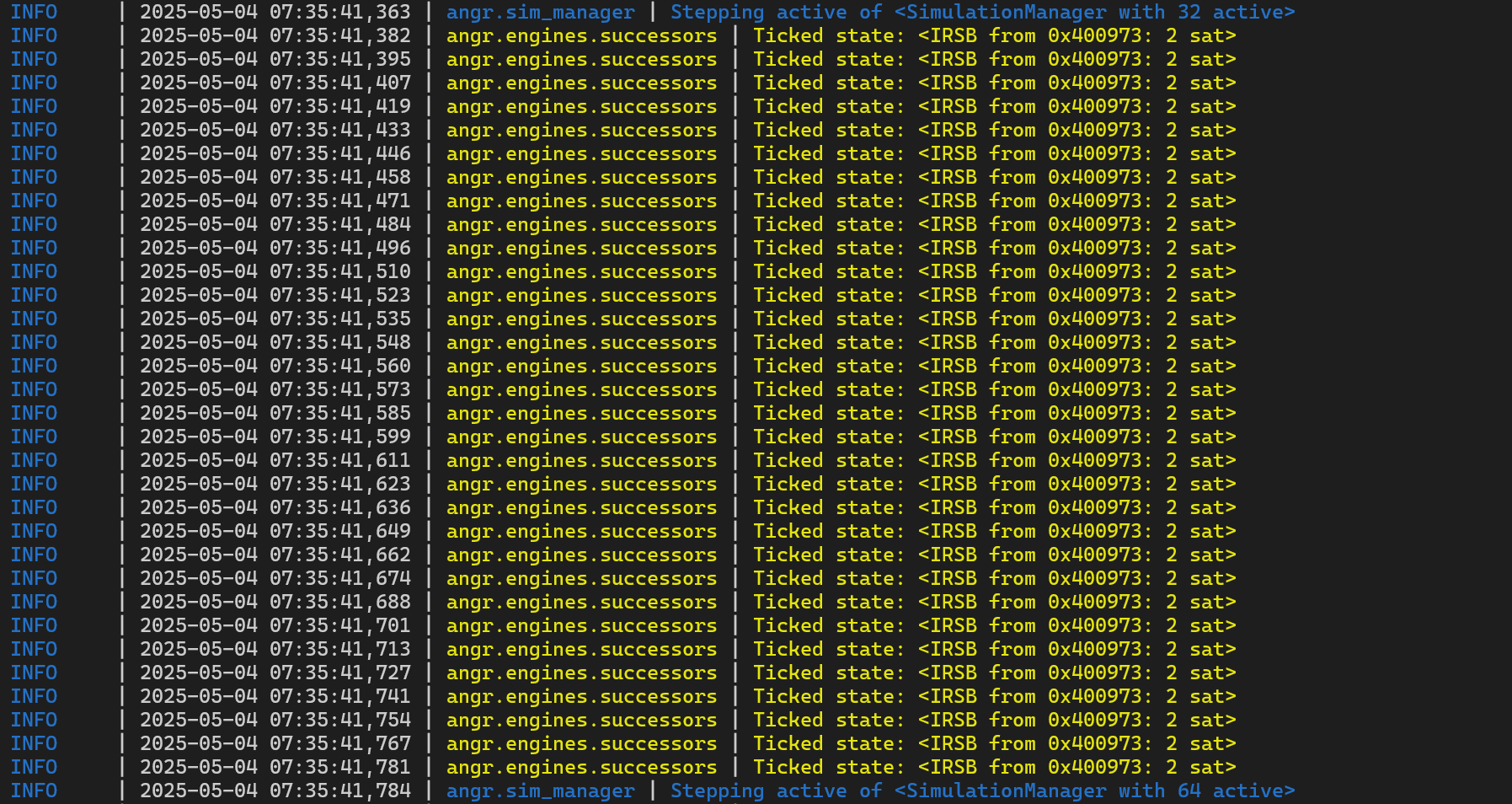
Let’s check in IDA to see what’s that.

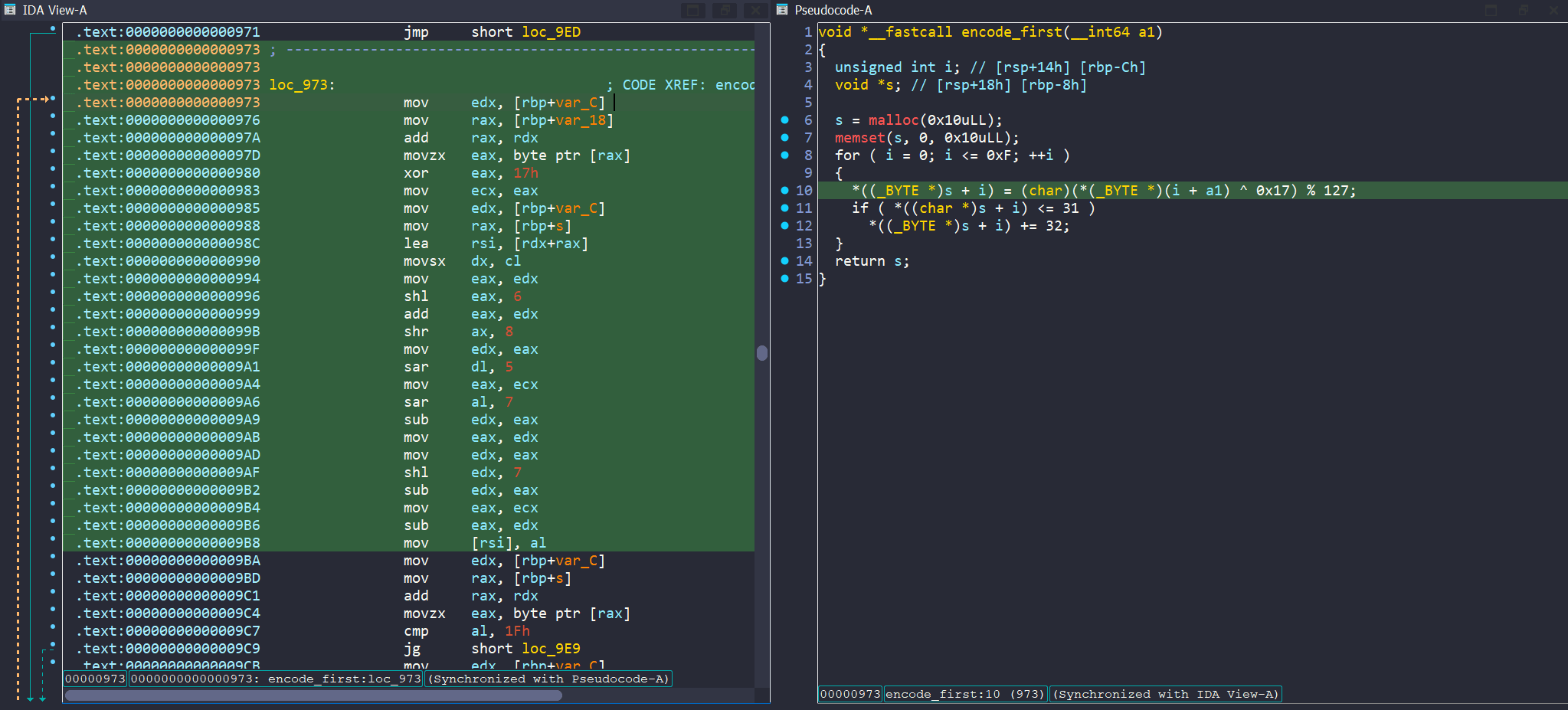
Yes, that’s the problem. We stuck in a for loop with a condition brach checking. This means each time the loop runs, angr has to deal with two possible paths:
- One for the condition being true
- One for false
This leads to branch explosion, where angr ends up trying to explore every possible path through the loop, causing the number of states to grow exponentially.
To solve this, we can use the veritesting=True option when creating the Simulation Manager. This tells angr to track execution using the Program Counter. So when different paths in a loop land at the same place (address) in the code, angr will merge those states, cutting down the number of paths it needs to follow.
simulation = proj.factory.simgr(init_state, veritesting=True)And we successfully get the correct input for our challenge.

Solution
Read It And Weep Final Script
import angr
import logging
import sys
import claripy
import string
logging.getLogger("angr").setLevel(logging.INFO)
def hook(l=None):
if l:
locals().update(l)
import IPython
IPython.embed(banner1='', exit_msg='', confirm_exit=False)
exit(0)
def failure_message(state):
return b"Sorry, that's not correct!" in state.posix.dumps(sys.stdout.fileno())
def success_message(state):
return b"Correct! Here is your flag:" in state.posix.dumps(sys.stdout.fileno())
def main():
proj = angr.Project("./read_it")
user_data_in_bytes = 64
user_data = claripy.BVS("message", user_data_in_bytes*8)
init_state = proj.factory.entry_state(stdin=user_data)
# Ensure user_data is printable
for i in range(user_data_in_bytes):
init_state.solver.add(
claripy.Or(*(
user_data.get_byte(i) == x
for x in string.printable.encode('utf-8')
))
)
# Prepare simulation
simulation = proj.factory.simgr(init_state, veritesting=True)
# Get address of read_and_print_flag function
print_flag_addr = proj.loader.find_symbol("read_and_print_flag").rebased_addr
simulation.explore(find=print_flag_addr, avoid=failure_message)
# Another way:
# simulation.explore(find=success_message, avoid=failure_message)
if not simulation.found:
print("NOT FOUND")
hook(locals())
for solution_state in simulation.found:
solution = solution_state.solver.eval(user_data, cast_to=bytes)
# solution = solution_state.posix.stdin.concretize()
print(solution)
if __name__=="__main__":
main()Into the Metaverse
Analyze the Binary
Initially, load the binary ./metaverse and press F5 to get the pseudo-code in IDA. In main, we can see that it reads input from stdin with the size of 64 bytes. Then there is a function strcspn(), which returns the length of user_input until reaching the first \n. If the character \n is included in our user_input, it will be replaced by the terminating character \x00.
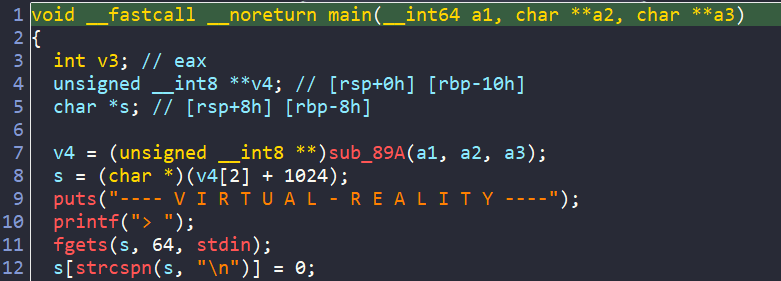
For further reading about strcspn(), you can visit this link: strcspn()
There are also a bunch of if-else and switch cases inside main, which do some magic there and then call a series of sub functions depending on the value of v3 and v4.
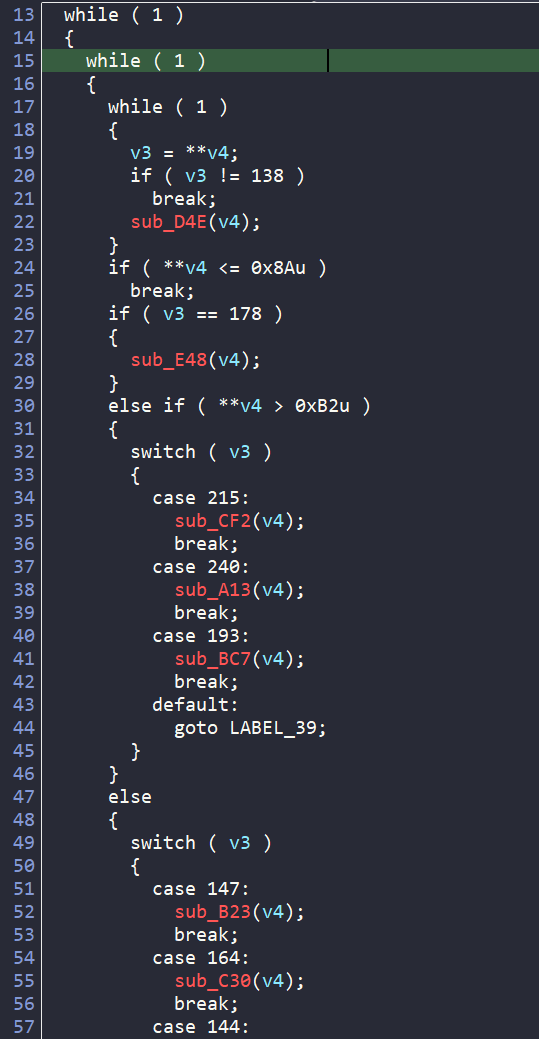
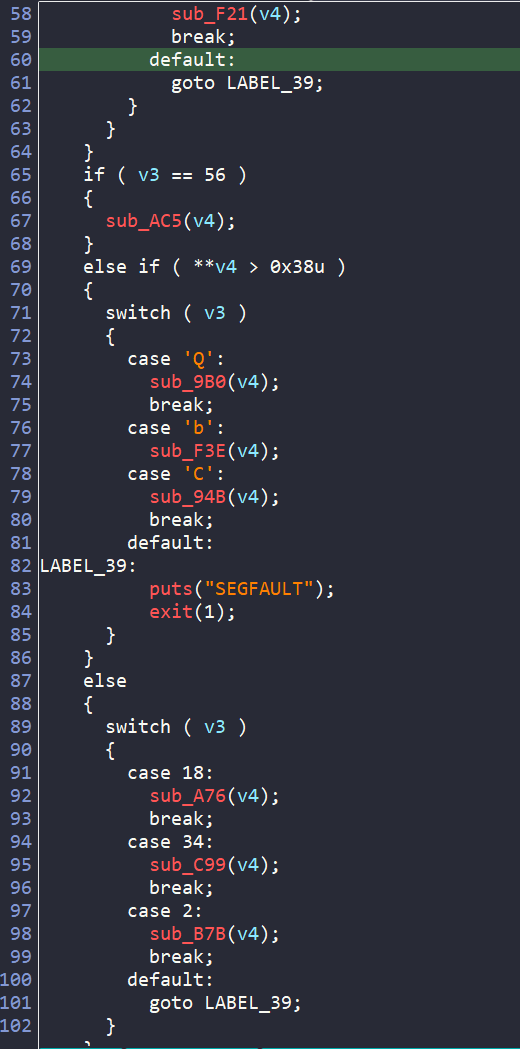
By chance, when checking each of the sub functions, I find the sub_F3E() which prints the success or failure message.
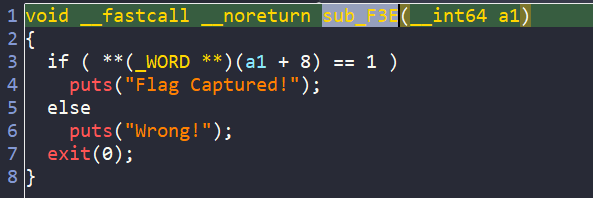
So, our goal is asking angr to create for us an input, which satisfies all the conditions and comes up to the path containing the string “Flag Captured!”.
Build the script
As usual, let’s import all the necessary libraries, use the LOGGING INFO and IPython debugging view, and have a quick check to see if our script is running correctly.
import angr
import logging
import claripy
import string
import sys
logging.getLogger("angr").setLevel(logging.INFO)
def hook(l=None):
if l:
locals().update(l)
import IPython
IPython.embed(banner1='', exit_msg='', confirm_exit=False)
exit(0)
proj = angr.Project("./metaverse")
hook(locals())
Everything is ready, now let’s take the advantage of IPython debugging view to create and run a Simulation Manager to see can we reach the deadended. Who knows, may be we get the answer :D

Nice, we reach the deadended.

Let’s see what we have here! Here, I use posix to let me call directly to .stdin. But why stdin here?
For simplication, just think about Client-Server Communication, where Server transfers data to Client. That data is printed to the terminal, so in context of posix, we use stdout. On the other hand, when Client transfers data to Server, we must type data to the terminal, so again, we use stdin in posix.

And for the outputs which we get, both the inputs are wrong!

If you look closely at the first input, there is a series of \x00 inside the payload. This is the undefined behaviour of strcspn() in angr.
In terms of strcspn(), it must read the concrete value so that it can find where the character \n appears in the input. But in case of angr, our input is compiled into symbolic value, which means we don’t have the concrete value! So when angr is running, strcspn() by default might add tons of \x00 characters into the input as any symbolic value from the input could be a \n.
To solve this, we will create a hook for strcspn() function. In my case, I will hook only 5 bytes for the call to strcspn() with a nop() function returning the size of our input (we can return a random size but should be large enough).

Here is how I implement that.
def nop(state):
state.regs.rax=64 # return the size of input
addr_to_hook = 0x400FEF
proj.hook(addr=addr_to_hook, hook=nop, length=5)To make our angr script faster, we can include the path where we want to stop or avoid.

def success_message(state):
return b"Flag Captured!" in state.posix.dumps(sys.stdout.fileno())
def failure_message(state):
return b"Wrong!" in state.posix.dumps(sys.stdout.fileno())
init_state = proj.factory.entry_state()
simulation = proj.factory.simgr(init_state)
simulation.explore(find=success_message, avoid=failure_message)
if not simulation.found:
print("NOT FOUND")
hook(locals())
for solution_state in simulation.found:
solution = solution_state.posix.stdin.concretize()
print("Flag:", solution)Run the script and we have the flag.

Solution
Into The Metaverse Final Script
import angr
import logging
import claripy
import string
import sys
logging.getLogger("angr").setLevel(logging.INFO)
def hook(l=None):
if l:
locals().update(l)
import IPython
IPython.embed(banner1='', exit_msg='', confirm_exit=False)
exit(0)
def success_message(state):
return b"Flag Captured!" in state.posix.dumps(sys.stdout.fileno())
def failure_message(state):
return b"Wrong!" in state.posix.dumps(sys.stdout.fileno())
def nop(state):
state.regs.rax=0x40
def main():
proj = angr.Project("./metaverse")
# Create hook
addr_to_hook = 0x400FEF
proj.hook(addr=addr_to_hook, hook=nop, length=5)
# Start init_state
init_state = proj.factory.entry_state()
# Prepare simulation
simulation = proj.factory.simgr(init_state)
simulation.explore(find=success_message, avoid=failure_message)
# NOT FOUND
if not simulation.found:
print("NOT FOUND")
hook(locals())
# FOUND => concretize the input to get the concrete input
for solution_state in simulation.found:
solution_password = solution_state.posix.stdin.concretize()
print("Flag:", solution_password)
if __name__=="__main__":
main()00_angr_find
Analyze the Binary
After loading the binary ./00_angr_find into IDA, we can see that the main is really short and straightforward. We are asked to enter an 8-byte user input. Then each character from our input is passed into a function named complex_funcion, which does some math if those characters are between A and Z. Finally, the encoded input is compared to the hard-coded string JACEJGCS to get the success message.
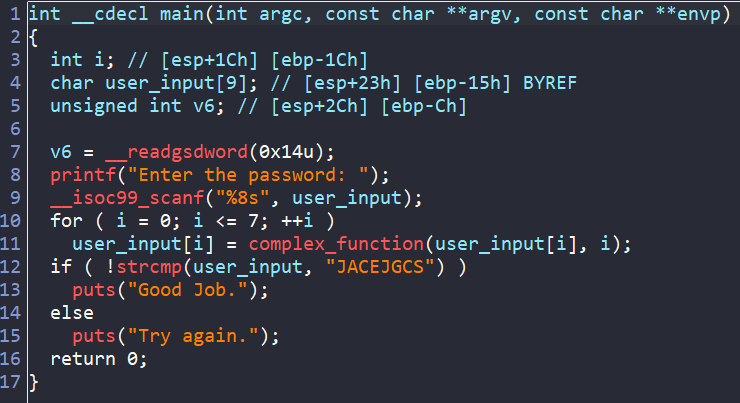
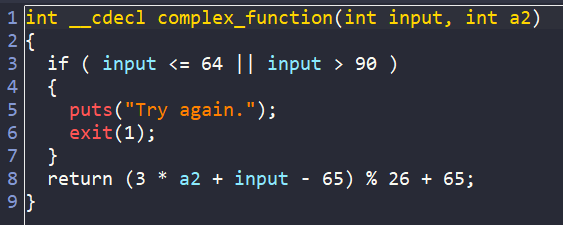
So, in general, we will create an angr script which leads us to the success message.
Build the script
As usual, I import all the necessary libraries, use the LOGGING INFO and IPython debugging view, and have a quick check to see if our script is running correctly.
import angr
import logging
logging.getLogger("angr").setLevel(logging.INFO)
def hook(l=None):
if l:
locals().update(l)
import IPython
IPython.embed(banner1='', exit_msg='', confirm_exit=False)
exit(0)
proj = angr.Project("../problems/00_angr_find")
hook(locals())
Now, we will create an initial state using entry_state(), where it loads all the registers, sets up the stack, heap, … as the real program for us. Then we pass it into Simulation Manager and try to force angr to go to the path of success message. In this case, we try to find the address where it prints the success message, or puts().
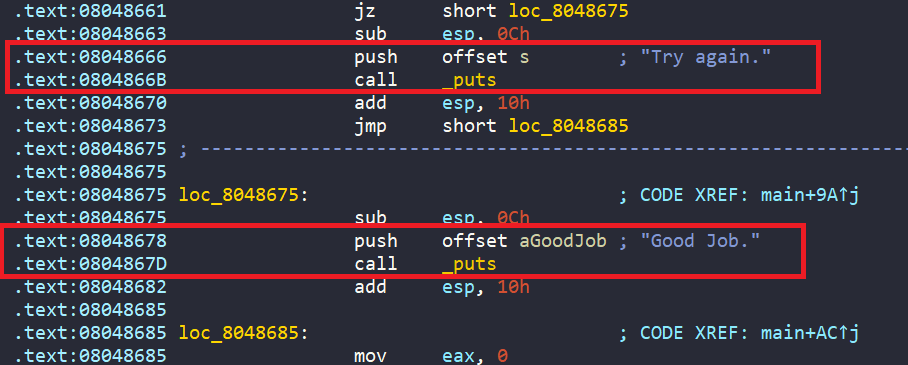

Nice, we have 1 found, meaning we successfully find the path to the success message.

Let’s read the input from stdin and we have the required input!


Solution
00_angr_find Final Script
import angr
import logging
logging.getLogger("angr").setLevel(logging.INFO)
def hook(l=None):
if l:
locals().update(l)
import IPython
IPython.embed(banner1='', exit_msg='', confirm_exit=False)
exit(0)
def main():
proj = angr.Project("../problems/00_angr_find")
# Prepare simulation
init_state = proj.factory.entry_state()
simulation = proj.factory.simgr(init_state)
# Find success message
print_success_addr = 0x0804867D
print_failure_addr = 0x0804866B
simulation.explore(find=print_success_addr, avoid=print_failure_addr)
# If found -> Read the input from stdin
if simulation.found:
for s in simulation.found:
flag = s.posix.stdin.concretize()
print("Flag: ", flag)
else:
print("NOT FOUND")
hook(locals())
if __name__=="__main__":
main()01_angr_avoid
Analyze the Binary
The main of this challenge is way too big, IDA can’t even decompile the main xD. Nevermind, let’s head to the main. We see that it asks us to enter an 8-byte user input. Then each character from user input is encoded by the the complex_function().
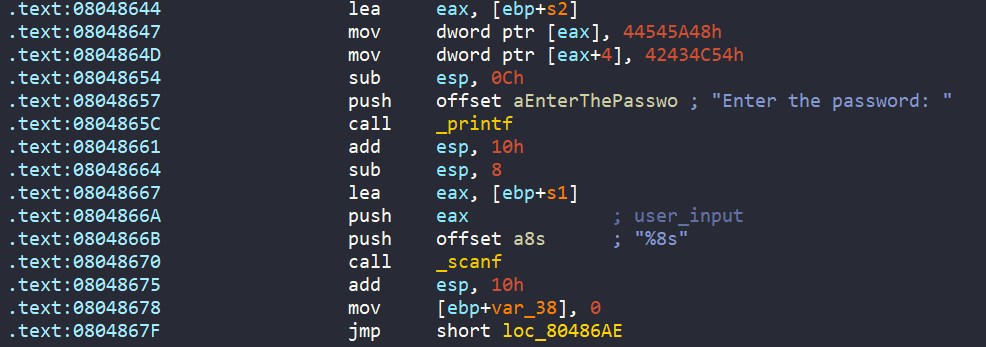
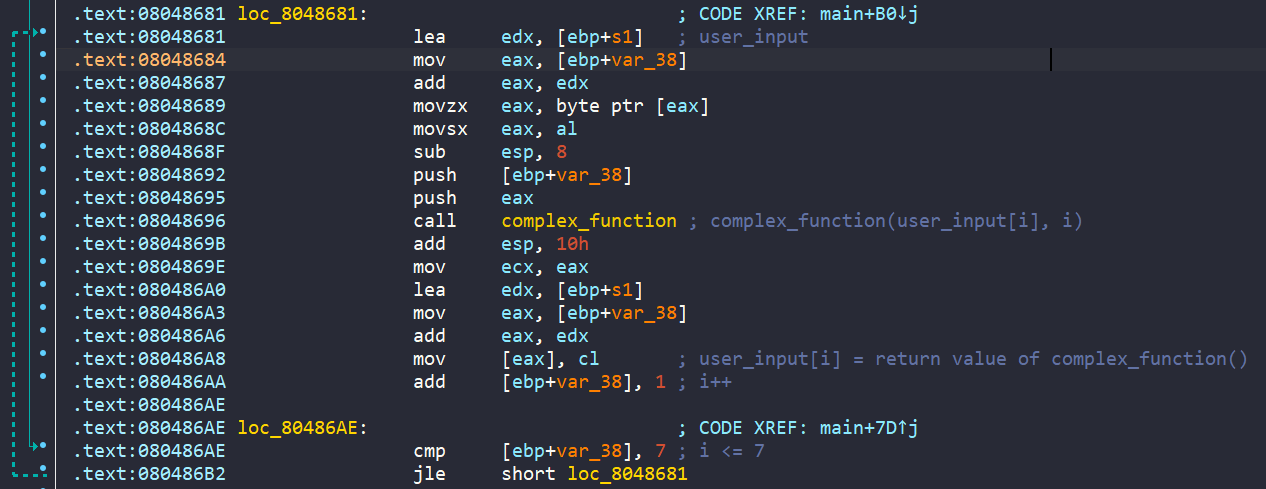
Then there are tons of maths, comparisions, and jumps to many different labels.
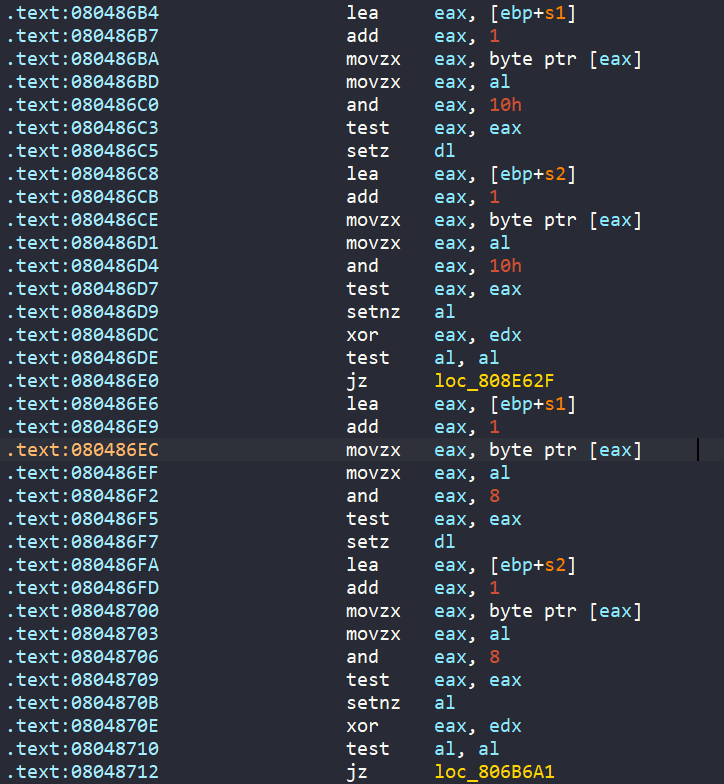
Sorry, the main is just too big, I can’t give you all the way it looks, but in general, each jump to label will eventually land into a function named avoid_me.

For avoid_me, it just sets variable should_succeed to zero.
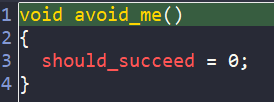
Furthermore, in main, there is call to maybe_good, where we get the success message only if should_succeed and comparision between s1 and s2 are true.

Clearly, the success message is prevented by the avoid_me function. So for running in angr, we will avoid that function, and the address that prints the failure message.

Build the script
Let’s import libraries, use LOGGING INFO and IPython debugging view, and test to see if our script is running correctly.
import angr
import logging
import sys
logging.getLogger("angr").setLevel(logging.INFO)
def hook(l=None):
if l:
locals().update(l)
import IPython
IPython.embed(banner1='', exit_msg='', confirm_exit=False)
exit(0)
proj = angr.Project("../problems/01_angr_avoid")
hook(locals())
Now, we create initial state and pass it into Simulation Manager.

Next, we force angr into finding the success message, and avoid avoid_me function + failure message. We can use the syntax below to find the avoid_me function in the binary.
<func_name> = proj.loader.find_symbol("<func_name>").rebased_addr

We have 1 found, our script is running greate :D

Let’s read the input and we have the flag


Solution
01_angr_avoid Final Script
import angr
import logging
import sys
logging.getLogger("angr").setLevel(logging.INFO)
def hook(l=None):
if l:
locals().update(l)
import IPython
IPython.embed(banner1='', exit_msg='', confirm_exit=False)
exit(0)
def main():
proj = angr.Project("../problems/01_angr_avoid")
# Prepare simulation
init_state = proj.factory.entry_state()
simulation = proj.factory.simgr(init_state)
# avoid_me() address
avoid_me = proj.loader.find_symbol("avoid_me").rebased_addr
# Run simulation, avoid avoid_me() and failure message
simulation.explore(find=0x080485E5, avoid=[avoid_me, 0x080485F7])
# NOT FOUND
if not simulation.found:
print("NOT FOUND")
hook(locals())
# FOUND
for solution_state in simulation.found:
print(solution_state.posix.stdin.concretize())
if __name__=="__main__":
main()02_angr_find_condition
Analyze the Binary
After loading the binary 02_angr_find_condition into IDA, here is the pseudo-code of main.
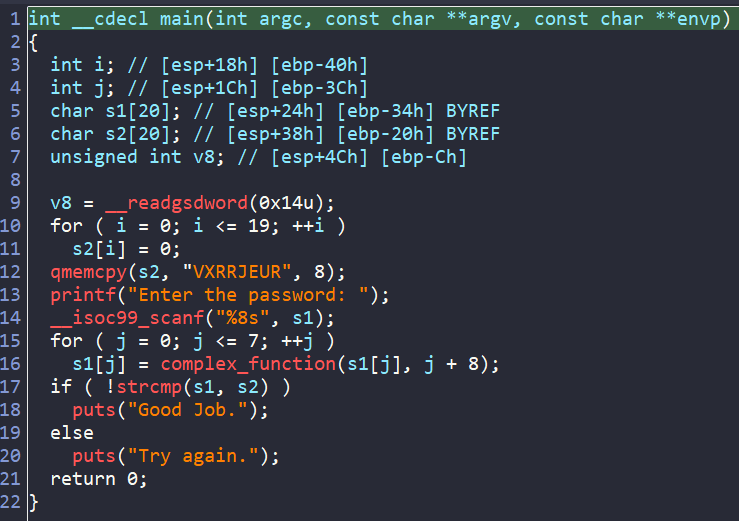
The main is short and straightforward. Basically, we encode each character of our 8-byte input via a function named complex_funcion. Then that encoded input is compared to a hard-coded string VXRRJEUR stored in variable s2 to get the success message.
Here is how complex_function looks like.
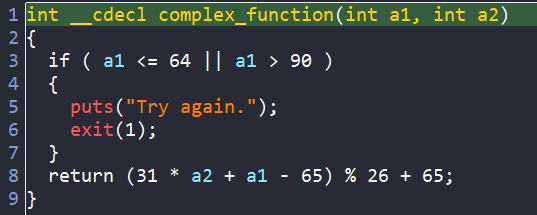
So, the general flow of our angr script is to create Simulation Manager, and find the address of puts() function which prints the success message. However, this time, we use another technique which finds the strings “Good Job.” from stdout.
Build the script
As usual, I load the necessary libraries, use LOGGING INFO and IPython debugging view, and test to see if our script is running properly.
import angr
import logging
import sys
logging.getLogger("angr").setLevel(logging.INFO)
def hook(l=None):
if l:
locals().update(l)
import IPython
IPython.embed(banner1='', exit_msg='', confirm_exit=False)
exit(0)
proj = angr.Project("../problems/02_angr_find_condition")
hook(locals())
Our script is perfectly prepared. Now is time to create the Simulation Manager.

Here is the technique to find the success and failure message from stdout.

Then, we will pass these two functions into Simulation Manager to let it explore the path to the success message. Also, we can avoid the failure message to improve the speed of our angr script.

We have 1 found, just read that found from stdin to get the user input and we finish this challenge.


Solution
02_angr_find_condition Final Script
import angr
import logging
import sys
logging.getLogger("angr").setLevel(logging.INFO)
def hook(l=None):
if l:
locals().update(l)
import IPython
IPython.embed(banner1='', exit_msg='', confirm_exit=False)
exit(0)
def success_message(state):
return b"Good Job." in state.posix.dumps(sys.stdout.fileno())
def failure_message(state):
return b"Try again." in state.posix.dumps(sys.stdout.fileno())
def main():
proj = angr.Project("../problems/02_angr_find_condition")
# Prepare simualtion
init_state = proj.factory.entry_state()
simulation = proj.factory.simgr(init_state)
# Run simulation to find path to success message
simulation.explore(find=success_message, avoid=failure_message)
# Not found
if not simulation.found:
print("NOT FOUND")
hook(locals())
# Found => Print input from stdin in simulation
for s in simulation.found:
solution = s.posix.stdin.concretize()
print("Flag: ", solution)
if __name__=="__main__":
main()03_angr_symbolic_registers
Analyze the Binary
After loading the binary 03_angr_symbolic_registers into IDA, there is a call to get_user_input where we have to enter 3 inputs.
![03-pseudo-code-main-1.png]
Looking closely at get_user_input, our inputs are stored in ebp+var_10, ebp+var_14, and ebp+var_18. Then, those three values are loaded into three registers edx, ebx, and eax respectively.
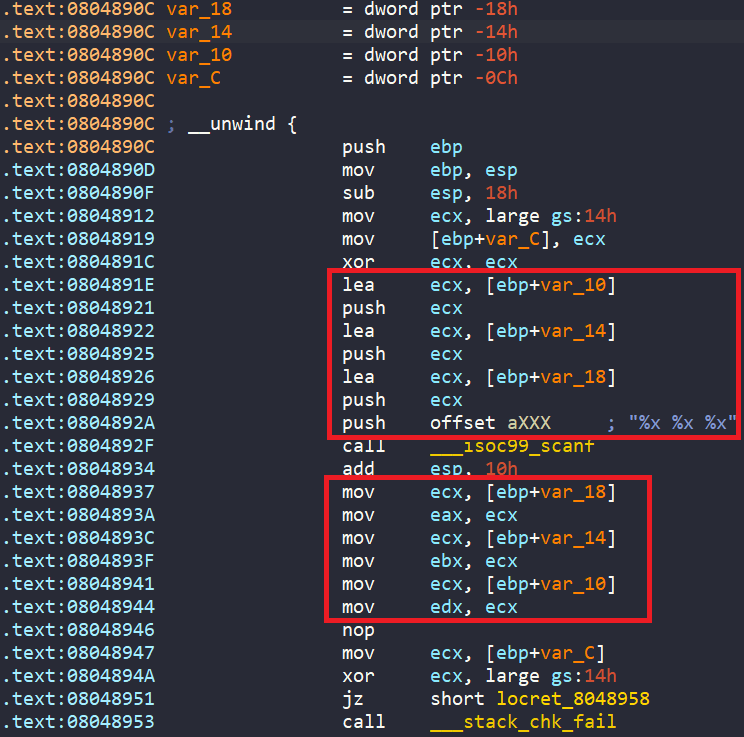
After get_user_input, the values from the three registers are loaded back into local variables to passed into complex_function_1, complex_function_2, and complex_function_3 to do some maths.
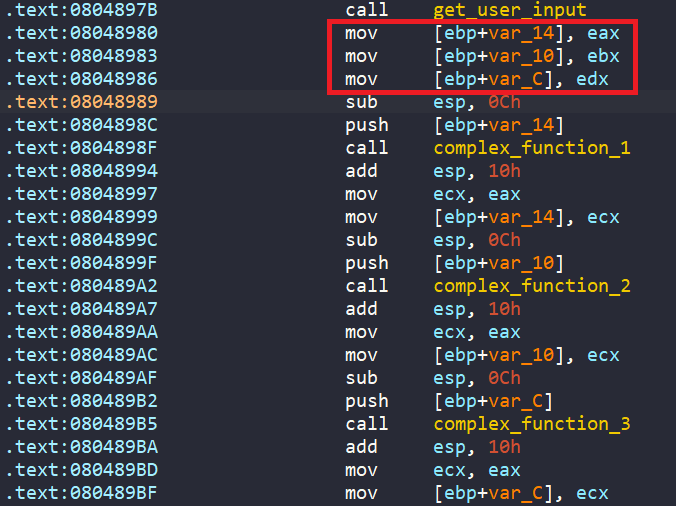
Finally, we can only get to the success message if all of the three registers are zero.
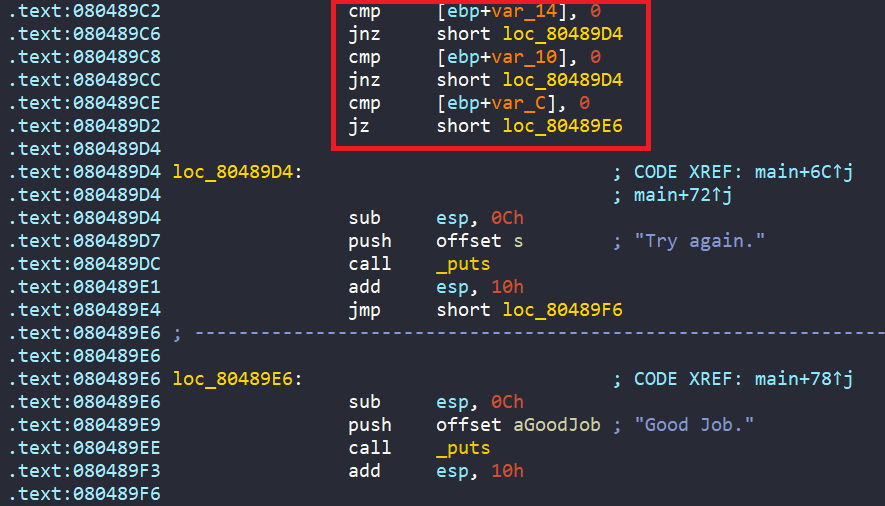
The goal for this challenge is to get the correct three inputs. However, those three inputs are loaded from three registers as shown above. To get easier, we should create three symbolic registers, and our job is to read the raw data stored in those symbolic registers.
But where should we start our program to create three symbolic registers? As we know that inside get_user_input function and outside get_user_input, we are all loaded data from the three registers.
But our best choice is to create three symbolic registers outside get_user_input. If we choose to create three symbolic registers inside get_user_input we have to handle the stack correctly because inside get_user_input we have a call to ___stack_chk_fail.
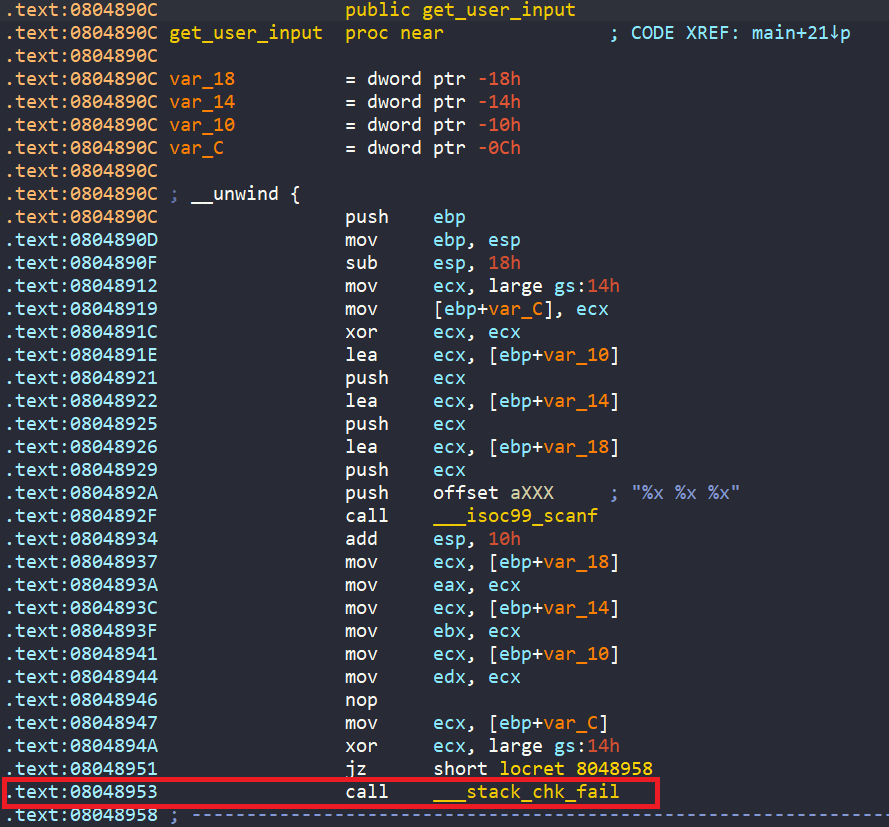
So, the address that we want our angr script to start is as below.

Build the script
As usual, I load the necessary libraries, use LOGGING INFO and IPython debugging view, and test to see if our script is running properly.
import angr
import logging
import sys
logging.getLogger("angr").setLevel(logging.INFO)
def hook(l=None):
if l:
locals().update(l)
import IPython
IPython.embed(banner1='', exit_msg='', confirm_exit=False)
exit(0)
proj = angr.Project("../problems/03_angr_symbolic_registers")
hook(locals())
Now, we will start our angr script at address 0x08048980.

Then we create three symbolic registers. Furthermore, the size of each symbolic register is 4 bytes since they are loaded into 3 stacks layouts which have 4 bytes difference.

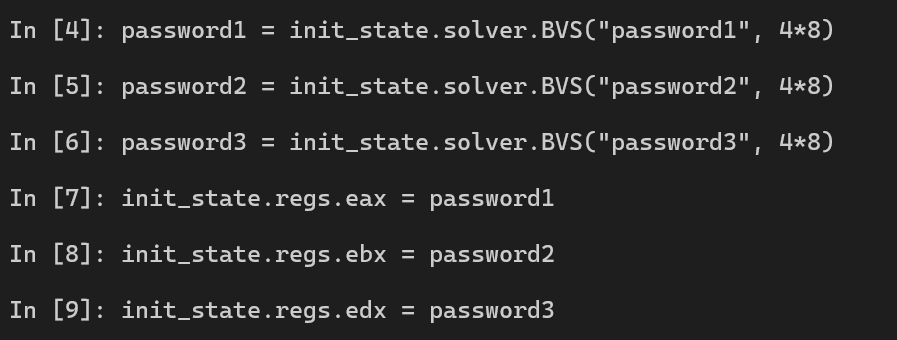
Let’s force angr to find the success path for us by exploring the string “Good Job.” from stdout. To improve the speed, we can avoid the paths lead to the string “Try again.”.

We successfully find the solution with 1 found. Let’s concretize the three symbolic registers and we should have the passwords for this challenge.
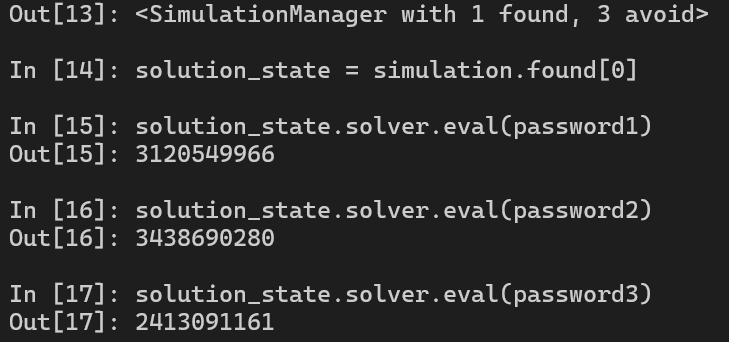
Because in the first place, we are asked to enter hex values, we must cast it to hex to solve this challenge.
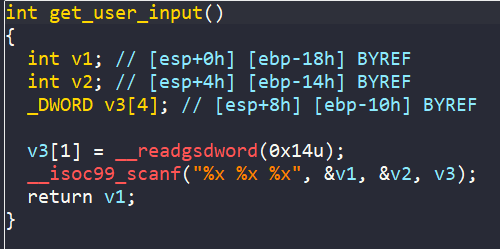

Solution
03_angr_symbolic_registers Final Script
import angr
import logging
import sys
logging.getLogger("angr").setLevel(logging.INFO)
def hook(l=None):
if l:
locals().update(l)
import IPython
IPython.embed(banner1='', exit_msg='', confirm_exit=False)
exit(0)
def success_message(state):
return b"Good Job." in state.posix.dumps(sys.stdout.fileno())
def failure_message(state):
return b"Try again." in state.posix.dumps(sys.stdout.fileno())
def main():
proj = angr.Project("../problems/03_angr_symbolic_registers")
# Create init_state from address after get_user_input()
start_addr = 0x08048980
init_state = proj.factory.blank_state(addr=start_addr)
# Create 3 symbolic variables for simulation (registers)
size_in_bytes = 4
password1 = init_state.solver.BVS("password1", size_in_bytes*8)
password2 = init_state.solver.BVS("password2", size_in_bytes*8)
password3 = init_state.solver.BVS("password3", size_in_bytes*8)
# Write 3 symbolic variables to 3 registers in current state
init_state.regs.eax = password1
init_state.regs.ebx = password2
init_state.regs.edx = password3
# Up till now, our state is ready
# Let's prepare simulation and find the success message
simulation = proj.factory.simgr(init_state)
simulation.explore(find=success_message, avoid=failure_message)
# NOT FOUND
if not simulation.found:
print("NOT FOUND")
hook(locals())
# FOUND ==> Read the password from our 3 pre-created symbolic variables (value inside registers)
for s in simulation.found:
solution_password1 = s.solver.eval(password1)
solution_password2 = s.solver.eval(password2)
solution_password3 = s.solver.eval(password3)
# Print solutions in hex because __isoc99_scanf("%x %x %x", &v1, &v2, v3);
print("Flag: ", hex(solution_password1), hex(solution_password2), hex(solution_password3))
if __name__=="__main__":
main()04_symbolic_stack
Analyze the Binary
In main, we have a function named handle_user.
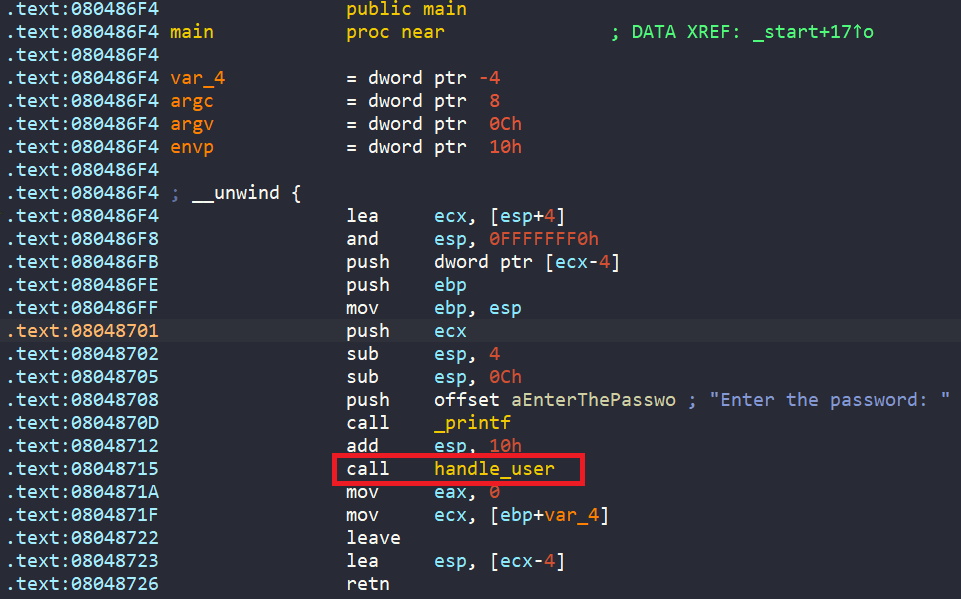
In this function, we are asked to enter 2 unsigned integers. Then our inputs will be encoded by complex_function0 and complex_function1, eventually being compared with some hard-coded values to get the success message.
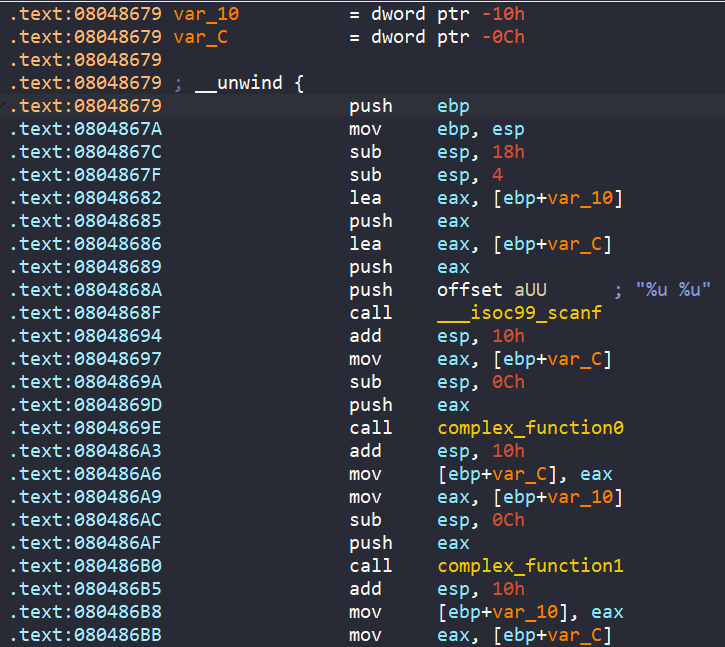
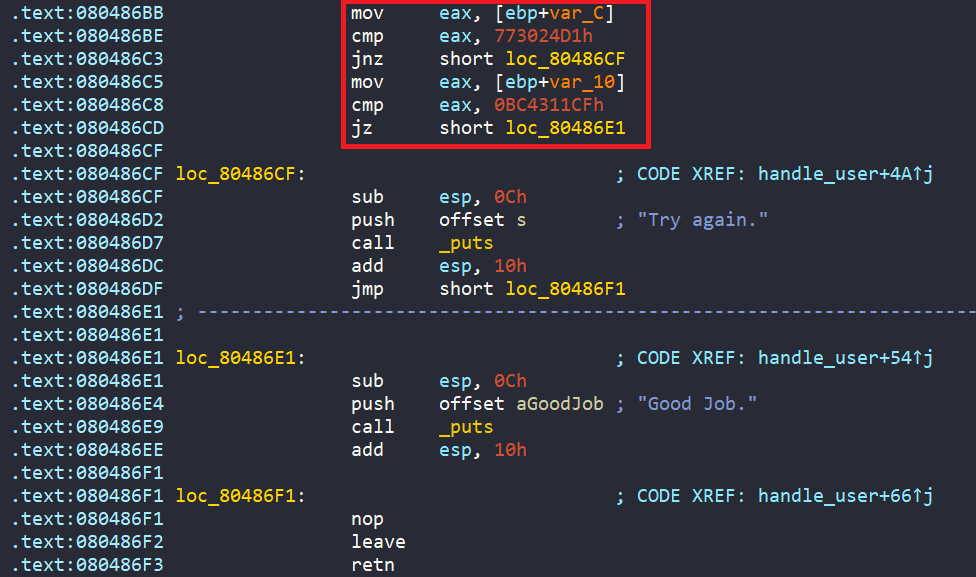
Clearly the two inputs are stored on the stack at ebp-0xc and ebp-0x10 respectively. So, in our angr script, we can simulation a stack, having the two stack slots be symbolic variables.
Build the script
Let’s import necessary libraries, use LOGGING INFO and IPython debugging view.
import angr
import logging
import sys
logging.getLogger("angr").setLevel(logging.INFO)
def hook(l=None):
if l:
locals().update(l)
import IPython
IPython.embed(banner1='', exit_msg='', confirm_exit=False)
exit(0)
proj = angr.Project("../problems/04_angr_symbolic_stack")
hook(locals())We already know that scanf stores two inputs onto the stack, so in angr script, the starting address should be after the scanf call and stack clean up.

start_addr = 0x08048697
init_state = proj.factory.blank_state(addr=start_addr)Right at the starting address 0x08048697, we will simulate the stack. As shown above, the inputs are stored at ebp-0xc and ebp-0x10, so our stack should also need to have two symbolic variables at ebp-0xc and ebp-0x10.
Stack looks like this.

Also the padding length for first input is 8 bytes.
size_in_bytes = 4
password1 = init_state.solver.BVS("password1", size_in_bytes*8)
password2 = init_state.solver.BVS("password2", size_in_bytes*8)
# Setup the stack
init_state.regs.ebp = init_state.regs.esp
stack_padding = 0x8
init_state.regs.esp -= stack_padding
# Insert password1 and password2 into stack
init_state.stack_push(password1)
init_state.stack_push(password2)Up to this point, the stack is ready. It’s time to prepare simulation and find success message.
def success_message(state):
return b"Good Job." in state.posix.dumps(sys.stdout.fileno())
def failure_message(state):
return b"Try again." in state.posix.dumps(sys.stdout.fileno())
simulation = proj.factory.simgr(init_state)
simulation.explore(find=success_message, avoid=failure_message)Run the script and we successfully have 1 found. Let’s concretize symbolic variables.
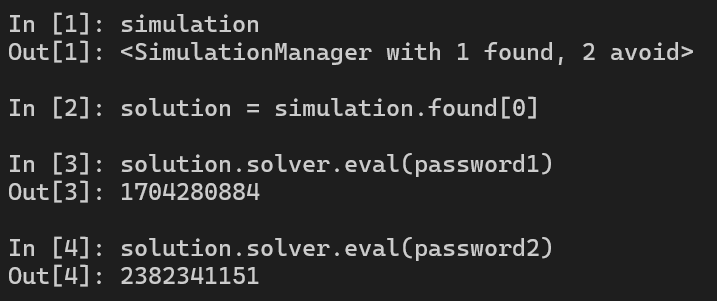

Solution
04_angr_symbolic_stack Final Script
import angr
import logging
import sys
logging.getLogger("angr").setLevel(logging.INFO)
def hook(l=None):
if l:
locals().update(l)
import IPython
IPython.embed(banner1='', exit_msg='', confirm_exit=False)
exit(0)
def success_message(state):
return b"Good Job." in state.posix.dumps(sys.stdout.fileno())
def failure_message(state):
return b"Try again." in state.posix.dumps(sys.stdout.fileno())
def main():
proj = angr.Project("../problems/04_angr_symbolic_stack")
# Create init_state with start address after stack clean up and scanf
# because we don't want to make symbolic scanf :>
start_addr = 0x08048697
init_state = proj.factory.blank_state(addr=start_addr)
# Create 2 symbolic variables holding symbolic values :P
# These 2 variables will replace 2 stack slots
size_in_bytes = 4
password1 = init_state.solver.BVS("password1", size_in_bytes*8)
password2 = init_state.solver.BVS("password2", size_in_bytes*8)
# Stack looks like this:
# -----------
# | | ebp - 0x4
# -----------
# | | ebp - 0x8
# -----------
# | password1 | ebp - 0xC
# -----------
# | password2 | ebp - 0x10
# -----------
#
# ===> padding for password1 in stack is 0x8 :>
# Setup the stack
init_state.regs.ebp = init_state.regs.esp
stack_padding = 0x8
init_state.regs.esp -= stack_padding
# Insert password1 and password2 into stack
init_state.stack_push(password1)
init_state.stack_push(password2)
# Up to this point, stack is ok
# => Prepare simulation and find the success message
simulation = proj.factory.simgr(init_state)
simulation.explore(find=success_message, avoid=failure_message)
# NOT FOUND
if not simulation.found:
print("NOT FOUND")
hook(locals())
# FOUND => print value in the stack from 2 symbolic variables
for s in simulation.found:
solution_password1 = s.solver.eval(password1)
solution_password2 = s.solver.eval(password2)
print("Flag: ", solution_password1, solution_password2)
if __name__=="__main__":
main()05_angr_symbolic_memory
Analyze the Binary
First of all, in main, we are asked to enter four string inputs stored in unk_A1BA1D8, unk_A1BA1D0, unk_A1BA1C8, and user_input.

Also, the four locations to store inputs are in the .bss section, meaning they are uninitialized.
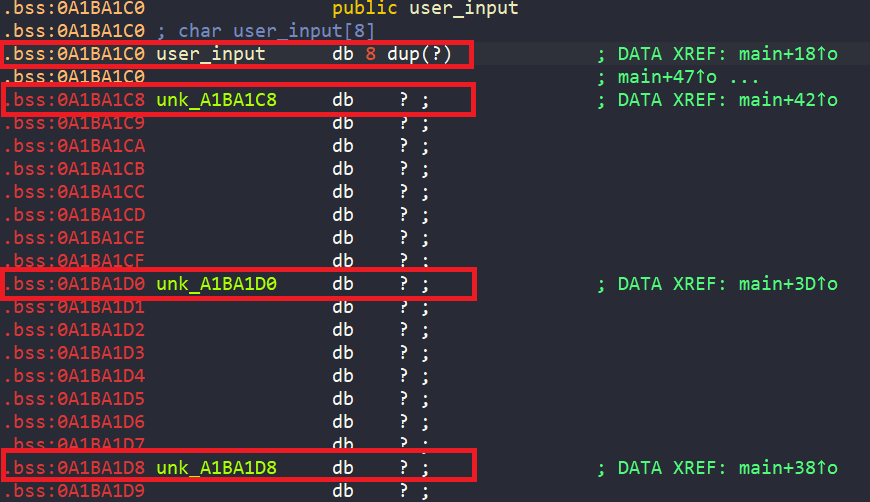
Furthermore, the four inputs will be encoded by complex_function if each of their character in range [A-Z]. After that, they are compared with a hard-coded string NJPURZPCDYEAXCSJZJMPSOMBFDDLHBVN to get the success message.

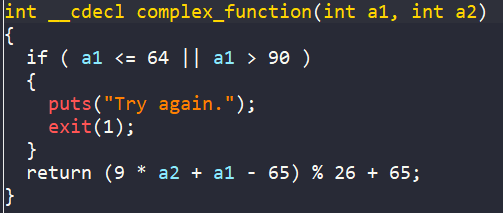
So, in this challenge, we move on to a new technique, where we will create four symbolic variables and assign them into four memory addresses in the .bss section via the syntax below.
state.memory.store(<addr>, <symbolic_variable>)Build the script
Let’s start importing necessary libraries, using LOGGING INFO, and IPython debugging view.
import angr
import logging
import sys
logging.getLogger("angr").setLevel(logging.INFO)
def hook(l=None):
if l:
locals().update(l)
import IPython
IPython.embed(banner1='', exit_msg='', confirm_exit=False)
exit(0)We then create angr project and initial state with the starting address after scanf and stack clean up.

proj = angr.Project("../problems/05_angr_symbolic_memory")
start_addr = 0x08048601
init_state = proj.factory.blank_state(addr=start_addr)Now, we create symbolic variables and stores them into uninitialized memory locations in the .bss section.
size_in_bytes = 8
password1 = init_state.solver.BVS("password1", size_in_bytes*8)
password2 = init_state.solver.BVS("password2", size_in_bytes*8)
password3 = init_state.solver.BVS("password3", size_in_bytes*8)
password4 = init_state.solver.BVS("password4", size_in_bytes*8)
init_state.memory.store(0x0A1BA1C0, password1)
init_state.memory.store(0x0A1BA1C8, password2)
init_state.memory.store(0x0A1BA1D0, password3)
init_state.memory.store(0x0A1BA1D8, password4)Finally, we force angr to find path to the success message. If we find the solution, concretize the symbolic variables. Since we are finding the string, we need to use cast_to=bytes.
def success_message(state):
return b"Good Job." in state.posix.dumps(sys.stdout.fileno())
def failure_message(state):
return b"Try again." in state.posix.dumps(sys.stdout.fileno())
simulation = proj.factory.simgr(init_state)
simulation.explore(find=success_message, avoid=failure_message)
if not simulation.found:
print("NOT FOUND")
hook(locals())
for solution_state in simulation.found:
solution_password1 = solution_state.solver.eval(password1, cast_to=bytes)
solution_password2 = solution_state.solver.eval(password2, cast_to=bytes)
solution_password3 = solution_state.solver.eval(password3, cast_to=bytes)
solution_password4 = solution_state.solver.eval(password4, cast_to=bytes)
print("Flag:", solution_password1, solution_password2, solution_password3, solution_password4) Run the script and we get the flag.

Solution
05_angr_symbolic_memory Final Script
import angr
import logging
import sys
logging.getLogger("angr").setLevel(logging.INFO)
def hook(l=None):
if l:
locals().update(l)
import IPython
IPython.embed(banner1='', exit_msg='', confirm_exit=False)
exit(0)
def success_message(state):
return b"Good Job." in state.posix.dumps(sys.stdout.fileno())
def failure_message(state):
return b"Try again." in state.posix.dumps(sys.stdout.fileno())
def main():
proj = angr.Project("../problems/05_angr_symbolic_memory")
# Create init_state with starting address after the scanf() and stack cleanup
start_addr = 0x08048601
init_state = proj.factory.blank_state(addr=start_addr)
# Create 4 symbolic variables for this:
# __isoc99_scanf("%8s %8s %8s %8s", user_input, &unk_A1BA1C8, &unk_A1BA1D0, &unk_A1BA1D8);
size_in_bytes = 0x8
password1 = init_state.solver.BVS("password1", size_in_bytes*8)
password2 = init_state.solver.BVS("password2", size_in_bytes*8)
password3 = init_state.solver.BVS("password3", size_in_bytes*8)
password4 = init_state.solver.BVS("password4", size_in_bytes*8)
# Using these 4 symbolic variables to overwrite 4 memory slots
# (memory of those 4 variables in actual program)
init_state.memory.store(0x0A1BA1C0, password1)
init_state.memory.store(0x0A1BA1C8, password2)
init_state.memory.store(0x0A1BA1D0, password3)
init_state.memory.store(0x0A1BA1D8, password4)
# Prepare simulation
simulation = proj.factory.simgr(init_state)
simulation.explore(find=success_message, avoid=failure_message)
# NOT FOUND
if not simulation.found:
print("NOT FOUND")
hook(locals())
# FOUND => print string from symbolic variables (using cast_to=bytes)
for s in simulation.found:
solution_password1 = s.solver.eval(password1, cast_to=bytes)
solution_password2 = s.solver.eval(password2, cast_to=bytes)
solution_password3 = s.solver.eval(password3, cast_to=bytes)
solution_password4 = s.solver.eval(password4, cast_to=bytes)
print("Flag: ", solution_password1, solution_password2, solution_password3, solution_password4)
if __name__=="__main__":
main()06_angr_symbolic_dynamic_memory
Analyze the Binary
The pseudo-code of main in IDA is straightforward, we are reading string inputs into memory locations allocated by malloc. If each character of those inputs is in range [A-Z], they will be encoded by function complex_function. Then the two encoded strings are compared to two hard-coded strings, UODXLZBI and UAORRAYF to get the success message.

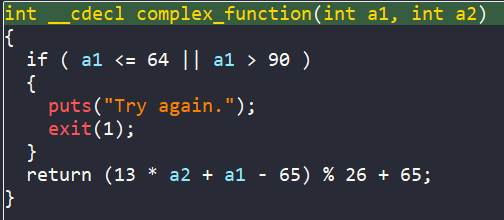
This is quite similar to challenge 05_angr_symbolic_memory right? :D
However, this time, we cannot directly write symbolic variables to memory locations because they are allocated by malloc (heap addresses, not addresses in .bss)
Instead, we can overwrite the pointer. This means, overwriting the pointer to make it point to our symbolic variables.
This can be achieved by creating fake heap addresses → link our symbolic variables to that fake heap addresses → make buffer0 and buffer1 pointers point to our fake heap addresses.
Build the script
Let’s import necessary libraries, use LOGGING INFO and IPython debugging view.
import angr
import logging
import sys
logging.getLogger("angr").setLevel(logging.INFO)
def hook(l=None):
if l:
locals().update(l)
import IPython
IPython.embed(banner1='', exit_msg='', confirm_exit=False)
exit(0)Then, we create angr project and initial state starting at address 0x080486A0 (after scanf and stack clean up).
The reason is that we create symbolic variables to replace the actual contents of buffer0 and buffer1, so we need to start at address after scanf, meaning before that our angr doesn’t have any data related to actual program buffer0 and buffer1.
On the other hand, if we use entry_state(), this means we already have buffer0 and buffer1 data of actual program, and our symbolic variables related to buffer0 and buffer1 running parallel. This might corrupt the working of angr.

proj = angr.Project("../problems/06_angr_symbolic_dynamic_memory")
start_addr = 0x08048699
init_state = proj.factory.blank_state(addr=start_addr)Now, let’s create symbolic variables and link them to fake heap addresses. After that, we link buffer0 and buffer1 pointers point to those fake heap addresses.
size_in_bytes = 8
password1 = init_state.solver.BVS("password1", size_in_bytes*8)
password2 = init_state.solver.BVS("password2", size_in_bytes*8)
fake_heap_addr = 0x0ABCC8C0
buffer0_addr = 0x0ABCC8A4
buffer1_addr = 0x0ABCC8AC
init_state.memory.store(buffer0_addr, fake_heap_addr, endness=proj.arch.memory_endness)
init_state.memory.store(buffer1_addr, fake_heap_addr+9, endness=proj.arch.memory_endness)
init_state.memory.store(fake_heap_addr, password1)
init_state.memory.store(fake_heap_addr+9, password2)Here I use the unuse memory from hex view for fake heap address.

Finally, we force angr to find the path to success message.
def success_message(state):
return b"Good Job." in state.posix.dumps(sys.stdout.fileno())
def failure_message(state):
return b"Try again." in state.posix.dumps(sys.stdout.fileno())
simulation = proj.factory.simgr(init_state)
simulation.explore(find=success_message, avoid=failure_message)
if not simulation.found:
print("NOT FOUND")
hook(locals())
for solution_state in simulation.found:
solution_password1 = solution_state.solver.eval(password1, cast_to=bytes)
solution_password2 = solution_state.solver.eval(password2, cast_to=bytes)
print("Flag:", solution_password1, solution_password2)We successfully have the flag.

Solution
06_angr_symbolic_dynamic_memory Final Script
import angr
import logging
import sys
logging.getLogger("angr").setLevel(logging.INFO)
def hook(l=None):
if l:
locals().update(l)
import IPython
IPython.embed(banner1='', exit_msg='', confirm_exit=False)
exit(0)
def success_message(state):
return b"Good Job." in state.posix.dumps(sys.stdout.fileno())
def failure_message(state):
return b"Try again." in state.posix.dumps(sys.stdout.fileno())
def main():
proj = angr.Project("../problems/06_angr_symbolic_dynamic_memory")
# Create init_state with start address after call to scanf() and stack clean up
start_addr = 0x08048699
init_state = proj.factory.blank_state(addr=start_addr)
# ------------------- IDEA --------------------
# We can't overwrite memory with symbolic variables
# because in this challenge, variables are dynamically allocated
# Instead, we can overwrite the pointer
# This means, overwriting the pointer to make it point to our symbolic variables
# This can be achieved by creating fake heap addresses,
# link our symbolic variables to that fake heap addresses.
# Make dynamic pointers point to our fake heap addresses.
# Address of 2 dynamic pointers + fake heap address (unuse memory in hex views)
fake_heap_addr = 0x0ABCC8C0
buffer0_addr = 0x0ABCC8A4
buffer1_addr = 0x0ABCC8AC
# Create 2 symbolic variables
size_in_bytes = 0x8
password1 = init_state.solver.BVS("password1", size_in_bytes*8)
password2 = init_state.solver.BVS("password2", size_in_bytes*8)
# Make 2 dynamic pointers point to our fake heap address (remember the endianess)
init_state.memory.store(buffer0_addr, fake_heap_addr, endness=proj.arch.memory_endness)
init_state.memory.store(buffer1_addr, fake_heap_addr+9, endness=proj.arch.memory_endness)
# Link symbolic variables to fake heap address memory
init_state.memory.store(fake_heap_addr, password1)
init_state.memory.store(fake_heap_addr+9, password2)
# Now everything is ready, let's prepare simulation and run
simulation = proj.factory.simgr(init_state)
simulation.explore(find=success_message, avoid=failure_message)
# NOT FOUND
if not simulation.found:
print("NOT FOUND")
hook(locals())
# FOUND => print string input from symbolic variables
for s in simulation.found:
solution_password1 = s.solver.eval(password1, cast_to=bytes)
solution_password2 = s.solver.eval(password2, cast_to=bytes)
print("Flag: ", solution_password1, solution_password2)
if __name__=="__main__":
main()07_angr_symbolic_file
Analyze the Binary
Here is the pseudo-code of main from IDA.
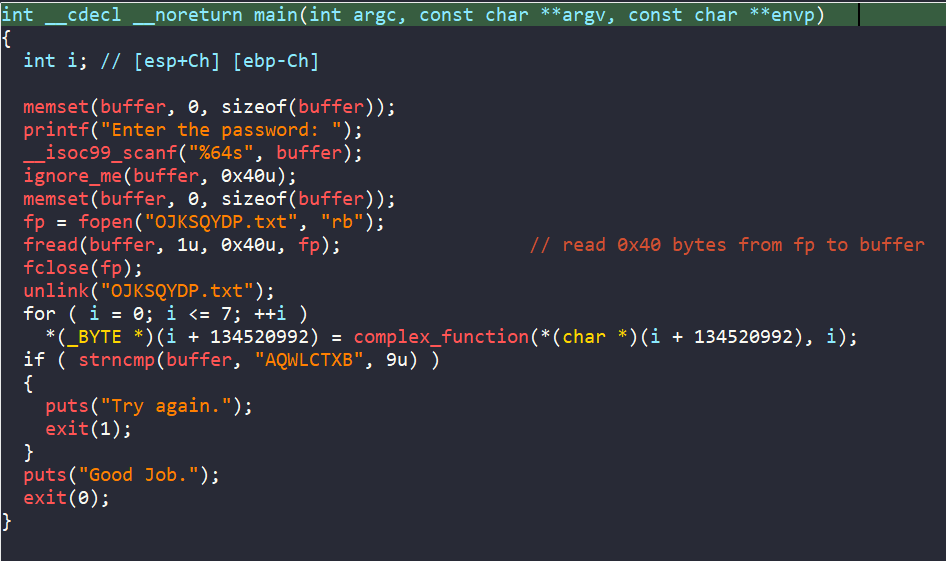
We are asked to enter a 64-byte password, and it is passed into the ignore_me function.
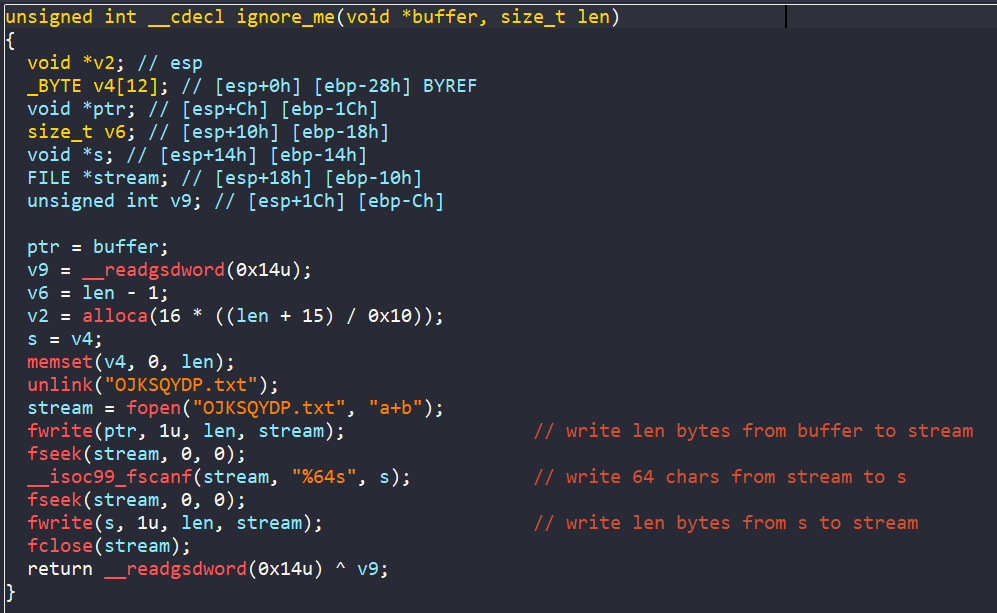
Clearly our input is writtent to the file OJKSQYDP.txt.
However, only 8 bytes of our input is encoded and compared to the string AQWLCTXB to get the success message even though we are asked to enter 64-byte input.

In this challenge, we will create a symbolic file. The file content should also be symbolic, with the length of 8 bytes since only 8 bytes of our file content is compared to the string AQWLCTXB. When reaching the success message, our job is to concretize the symbolic file content!
Build the script
Like normal, we start by importing necessary libraries, use LOGGING INFO and IPython debugging view.
import angr
import logging
import sys
logging.getLogger("angr").setLevel(logging.INFO)
def hook(l=None):
if l:
locals().update(l)
import IPython
IPython.embed(banner1='', exit_msg='', confirm_exit=False)
exit(0)Then, we create angr project and find an address to start angr.
proj = angr.Project("../problems/07_angr_symbolic_file")
# Create init_state with start address after scanf() and stack clean up
start_addr = 0x080488D3
init_state = proj.factory.blank_state(addr=start_addr)But why choosing starting address 0x080488D3?
Normally, we will choose address 0x080488C4, which is after scanf and stack cleanup.

However, if we start from this address, angr will go into the function ignore_me. Inside this function, there is a call to fscanf, which requires concrete value of stream (content of OJKSQYDP.txt) to write to variable s.
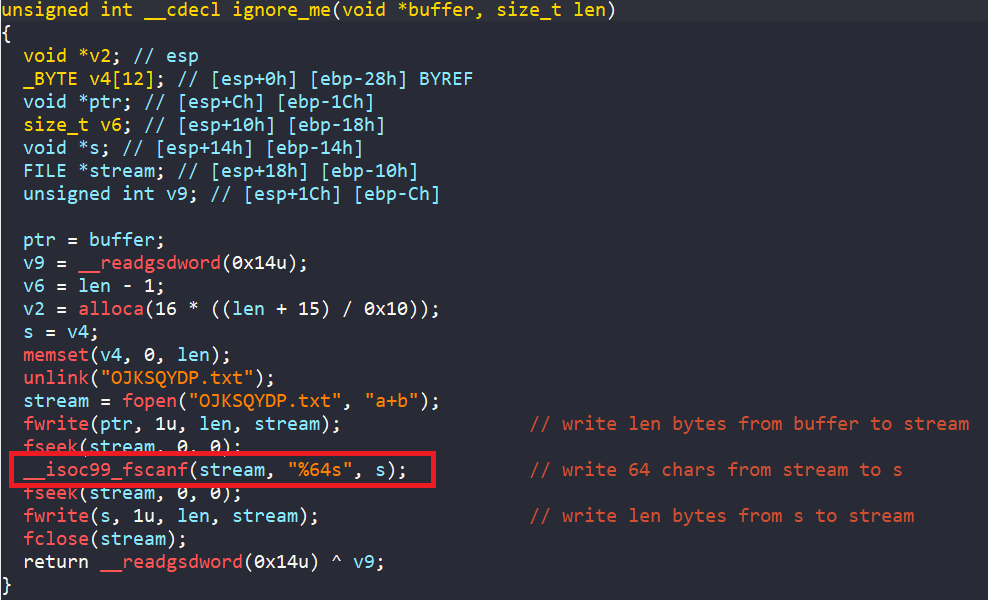
Like we have said before, we create symbolic file content to symbolic file. This means content of OJKSQYDP.txt at that moment is symbolic, where fscanf requires concrete value of file content. This has raised an error as shown below.

Back to our script, the next thing we should do is to create symbolic file content with length of 8 bytes and a simulation file.
# File name & file size
file_name = "OJKSQYDP.txt"
file_size = 0x40
# Create symbolic variable (content of our symbolic file)
size_in_bytes = 0x8
password = init_state.solver.BVS("password", size_in_bytes*8) # because strncmp(buffer, "AQWLCTXB", 9u)
# Create symbolic file, link file's content to symbolic variable
password_file = angr.SimFile(name=file_name, content=password, size=file_size)Now, we add symbolic file into our state file system, where there is a link between file_name and symbolic file.
init_state.fs.insert(file_name, password_file)⟹ This means that when angr does things like open(file_name) ⟹ it will dereference the symbolic file.
Finally, we prepare Simulation Manager and find the success message.
def success_message(state):
return b"Good Job." in state.posix.dumps(sys.stdout.fileno())
def failure_message(state):
return b"Try again." in state.posix.dumps(sys.stdout.fileno())
# NOT FOUND
if not simulation.found:
print("NOT FOUND")
hook(locals())
# FOUND => print file "OJKSQYDP.txt" content from symbolic variable (symbolic file content)
for s in simulation.found:
solution_file_content = s.solver.eval(password, cast_to=bytes)
print("Flag: ", solution_file_content)Run the script and we get the flag.

Solution
07_angr_symbolic_file Final Script
import angr
import logging
import sys
logging.getLogger("angr").setLevel(logging.INFO)
def hook(l=None):
if l:
locals().update(l)
import IPython
IPython.embed(banner1='', exit_msg='', confirm_exit=False)
exit(0)
def success_message(state):
return b"Good Job." in state.posix.dumps(sys.stdout.fileno())
def failure_message(state):
return b"Try again." in state.posix.dumps(sys.stdout.fileno())
def main():
proj = angr.Project("../problems/07_angr_symbolic_file")
# Create init_state with start address after scanf() and stack clean up
start_addr = 0x080488D3
init_state = proj.factory.blank_state(addr=start_addr)
# -------------------- IDEA ---------------------
# We need to create symbolic variables which is the file content of OJKSQYDP.txt
# Furthermore, we have to abort failure message
# ignore_me() writes input into OJKSQYDP.txt => SHOULD NOT ABORT
# So, our idea is to write symbolic content into this file
# When file contains symbolic content, it becomes symbolic file :P
# Then create symbolic file, link this file content to our symbolic variable
# After angr find path to success message, we just need to read value
# from symbolic variable and we win the challenge :>
# File name & file size
file_name = "OJKSQYDP.txt"
file_size = 0x40
# Create symbolic variable (content of our symbolic file)
size_in_bytes = 0x8
password = init_state.solver.BVS("password", size_in_bytes*8) # because strncmp(buffer, "AQWLCTXB", 9u)
# Create symbolic file, link file's content to symbolic variable
password_file = angr.SimFile(name=file_name, content=password, size=file_size)
# Add SymFile into our state file system
# where there is a link between file_name and symbolic file
# => When angr does things like open(file_name) => it will dereference the symbolic file :D
init_state.fs.insert(file_name, password_file)
# Prepare simulation
simulation = proj.factory.simgr(init_state)
simulation.explore(find=success_message, avoid=failure_message)
# NOT FOUND
if not simulation.found:
print("NOT FOUND")
hook(locals())
# FOUND => print file "OJKSQYDP.txt" content from symbolic variable (symbolic file content)
for s in simulation.found:
solution_file_content = s.solver.eval(password, cast_to=bytes)
print("Flag: ", solution_file_content)
if __name__=="__main__":
main()08_angr_constraints
Analyze the Binary
In main, a variable password stores a 16-byte hard-coded string AUPDNNPROEZRJWKB, and we are also asked to enter a 16-byte string stored in buffer.


Then our input buffer undergoes a loop which does some math to each character in range [A-Z] from function complex_function.

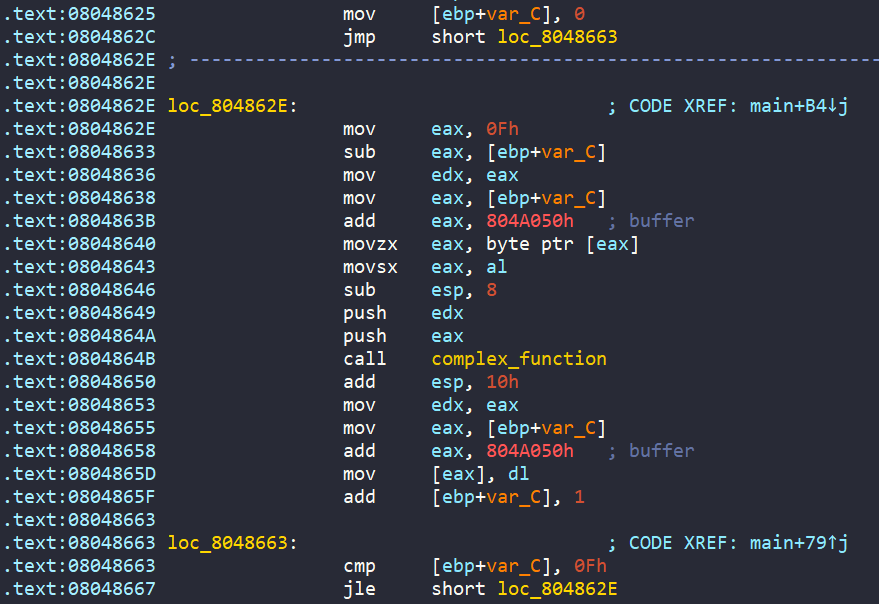
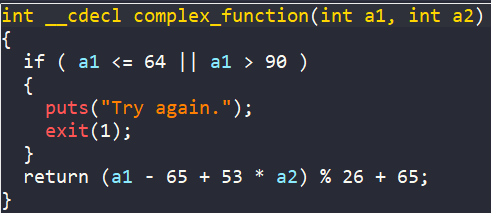
Eventually, there is a call to check_equals_AUPDNNPROEZRJWKB function, with buffer and 0x10 as arguments. If the return value is 1 (buffer and AUPDNNPROEZRJWKB are equal), we get the success message.
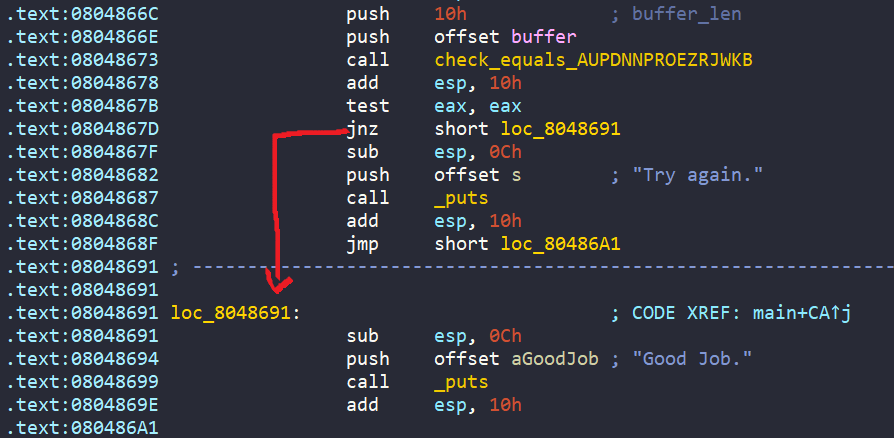

In general, the program wants us to enter a string into buffer, where after going through obfuscation in complex_function, the encoded string is equal to AUPDNNPROEZRJWKB.
What we really want is the input value (value of buffer), so we create a symbolic variable for buffer. However, if we just let angr go directly straight to the success message, angr will be extremely slow since function check_equals_AUPDNNPROEZRJWKB is checking character by character between buffer and AUPDNNPROEZRJWKB.
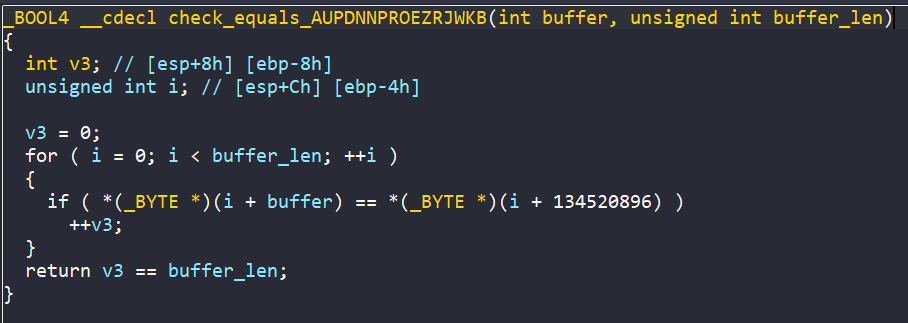
A clever way is instead of checking character by character from a loop, we directly add a constraint where buffer must be equal to AUPDNNPROEZRJWKB. This way angr will remove all the states where symbolic variable buffer isn’t equal to AUPDNNPROEZRJWKB, and also avoid that crazy loop.
Solution
First of all, we create a hook (custom function) to overwrite function check_equals_AUPDNNPROEZRJWKB to avoid the loop.
proj = angr.Project("../problems/08_angr_constraints")
def custom_check_equal(state):
buffer_addr = 0x0804A050
buffer_val = state.memory.load(buffer_addr, 16) # Load size is in bytes
password = "AUPDNNPROEZRJWKB"
state.regs.eax = claripy.If(
buffer_val == password,
claripy.BVV(1, 4*8), # true
claripy.BVV(0, 4*8) # false
)
addr_to_hook = 0x08048673
proj.hook(addr=addr_to_hook, hook=custom_check_equal, length=5)
We create initial state with entry_state to start everything from scratch, then pass it into Simulation Manager to find path to the success message.
def success_message(state):
return b"Good Job." in state.posix.dumps(sys.stdout.fileno())
def failure_message(state):
return b"Try again." in state.posix.dumps(sys.stdout.fileno())
init_state = proj.factory.entry_state()
simulation = proj.factory.simgr(init_state)
simulation.explore(find=success_message, avoid=failure_message)I will test this using LOGGING INFO and IPython debugging view.
import angr
import logging
import claripy
import sys
logging.getLogger("angr").setLevel(logging.INFO)
def hook(l=None):
if l:
locals().update(l)
import IPython
IPython.embed(banner1='', exit_msg='', confirm_exit=False)
exit(0)
hook(locals())We have 1 found. This is our flag, read it from stdin and we get it!


I have another solution!
Unlike the previous approach, where we created a custom_check_equal function to force angr to find the correct input from the start, in this solution we take a different route.
We add constraint to the symbolic variable right before the call to check_equals_AUPDNNPROEZRJWKB. This constraint helps angr narrow down the valid inputs from the possible range of symbolic values, rather than guiding it from the beginning.
You can view the source code for this solution in the link below.
Final script
08_angr_constraints Final Script
import angr
import logging
import claripy
import sys
logging.getLogger("angr").setLevel(logging.INFO)
def hook(l=None):
if l:
locals().update(l)
import IPython
IPython.embed(banner1='', exit_msg='', confirm_exit=False)
exit(0)
# Custom function to overwrite check_equals_AUPDNNPROEZRJWKB()
def custom_check_equal(state):
# Load value of user_data
user_data_addr = 0x0804A050
load_user_data = state.memory.load(user_data_addr, size=0x10)
# Password string
password_str = "AUPDNNPROEZRJWKB"
# Return value
state.regs.eax = claripy.If(
load_user_data == password_str,
claripy.BVV(1, 32), # true
claripy.BVV(0, 32) # false
)
def success_message(state):
return b"Good Job." in state.posix.dumps(sys.stdout.fileno())
def failure_message(state):
return b"Try again." in state.posix.dumps(sys.stdout.fileno())
def main():
proj = angr.Project("../problems/08_angr_constraints")
# Create hook for our custom function
addr_to_hook = 0x08048673
proj.hook(addr=addr_to_hook, hook=custom_check_equal, length=5)
# Should create entry_state because it loads everything from scratch
# If we use blank_state, we have to pre-defined most of the stack, heap, ...
# and the program is prone to crash if we don't handle that precisely :D
init_state = proj.factory.entry_state()
# Prepare simulation to the success path
simulation = proj.factory.simgr(init_state)
simulation.explore(find=success_message, avoid=failure_message)
# NOT FOUND
if not simulation.found:
print("NOT FOUND")
hook(locals())
for solution_state in simulation.found:
print(solution_state.posix.stdin.concretize())
if __name__=="__main__":
main()09_angr_hooks
Analyze the Binary
In main, the program asks us to enter a 16-byte string password into buffer. Also, there is a hard-coded string stored XYMKBKUHNIQYNQXE named password.
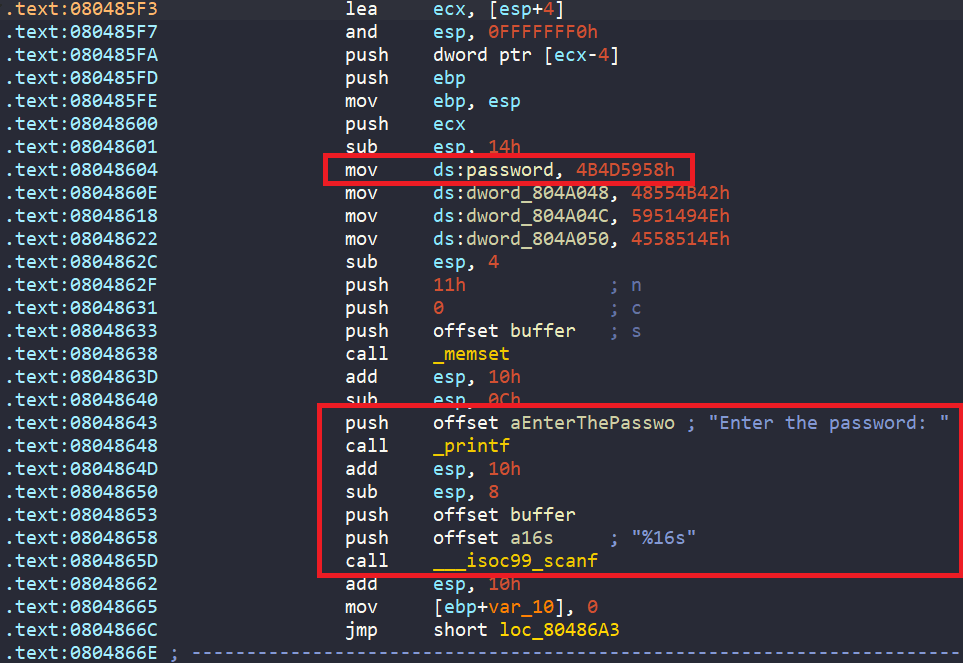

After that, each character in range [A-Z] of string buffer is encoded by complex_function.
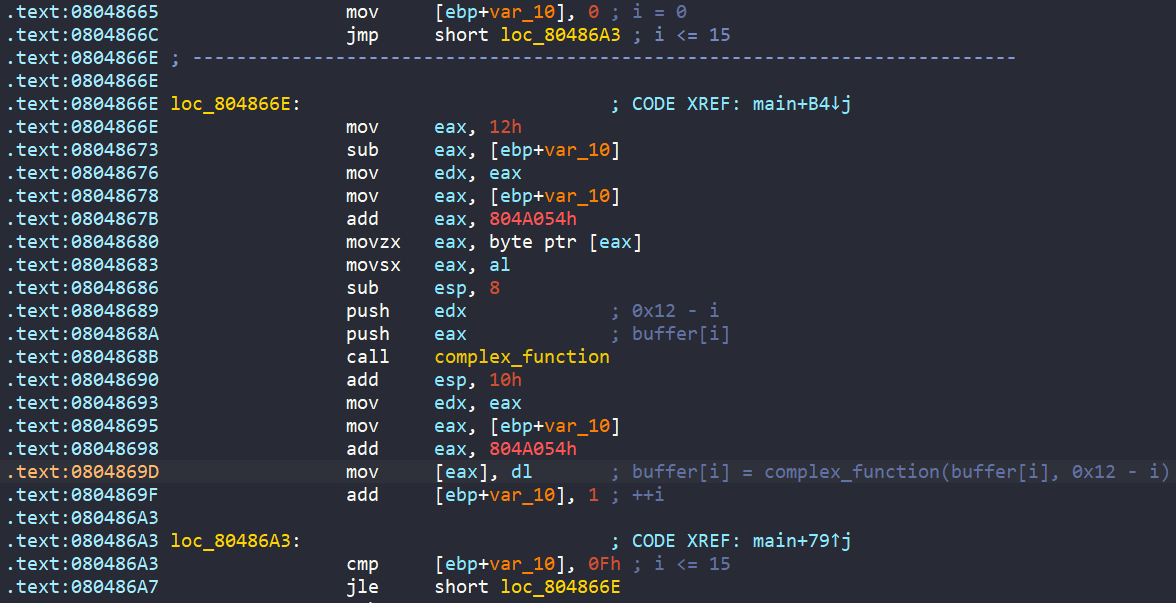

The encoded buffer is then passed to the check_equals_XYMKBKUHNIQYNQXE function to see if it matches the hardcoded password XYMKBKUHNIQYNQXE. The return value is stored into equals variable.

Furthermore, the hard-coded password XYMKBKUHNIQYNQXE is also encoded by the complex_function.
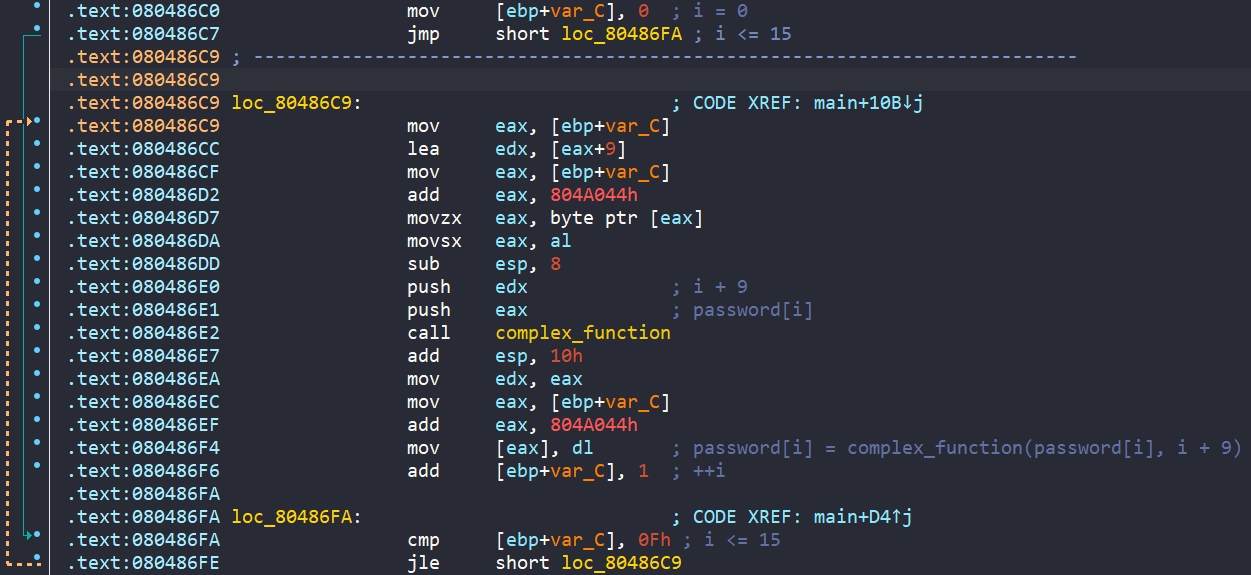
Finally, we are asked to enter a new value into buffer and it is being compared with the encoded password string. If both of them aren’t equal, we get failure message.
Moreover, if the previous call to check_equals_XYMKBKUHNIQYNQXE between XYMKBKUHNIQYNQXE and previous buffer returns value different to zero, we also get failure message.

So, our end goal is to reach success message. The program is straightforward, so we don’t need to create any symbolic variables, but we might face state explosion right at check_equals_XYMKBKUHNIQYNQXE. Because this function is checking character by character in a loop, this might make angr slow asf. To prevent it, we create a hook (custom function) where our input buffer must be equal to XYMKBKUHNIQYNQXE after being encoded.
Build the script
Like many other challenges, we import necessary libraries, use LOGGING INFO and IPython debugging view.
import angr
import logging
import claripy
import sys
logging.getLogger("angr").setLevel(logging.INFO)
def hook(l=None):
if l:
locals().update(l)
import IPython
IPython.embed(banner1='', exit_msg='', confirm_exit=False)
exit(0)Next, we create angr project and custom function (hook).
proj = angr.Project("../problems/09_angr_hooks")
# Hook
def custom_check_equal(state):
buffer_addr = 0x0804A054
buffer_val = state.memory.load(buffer_addr, 0x10)
password = "XYMKBKUHNIQYNQXE"
state.regs.eax = claripy.If(
buffer_val == password,
claripy.BVV(1, 32), # true
claripy.BVV(0, 32) # false
)
addr_to_hook = 0x080486B3
proj.hook(addr=addr_to_hook, hook=custom_check_equal, length=5)Finally, we create Simulation Manager to find the success message.
init_state = proj.factory.entry_state()
simulation = proj.factory.simgr(init_state)
simulation.explore(find=success_message, avoid=failure_message)
hook(locals()) # Open IPython debugging viewTesting with IPython debugging view, we have the solution.


Solution
09_angr_hooks Final Script
import angr
import logging
import claripy
import sys
logging.getLogger("angr").setLevel(logging.INFO)
def hook(l=None):
if l:
locals().update(l)
import IPython
IPython.embed(banner1='', exit_msg='', confirm_exit=False)
exit(0)
def custom_check_function(state):
# Load the value from user input, (in program, it is stored inside the variable "buffer")
buffer_addr = 0x0804A054
buffer_size_in_bytes = 0x10
load_buffer = state.memory.load(buffer_addr, buffer_size_in_bytes)
# Hard-coded password
hard_coded_password = "XYMKBKUHNIQYNQXE"
# Return value of our custom_check_function
state.regs.eax = claripy.If(
load_buffer == hard_coded_password,
claripy.BVV(1, 32), # true
claripy.BVV(0, 32) # false
)
def success_message(state):
return b"Good Job." in state.posix.dumps(sys.stdout.fileno())
def failure_message(state):
return b"Try again." in state.posix.dumps(sys.stdout.fileno())
def main():
proj = angr.Project("../problems/09_angr_hooks")
# ---------------------------------- IDEA -----------------------------------
# In this program, it asks us to enter two password for double check verification
# The first comparision checks between user_data and hard-coded password
# The second comparision checks between obfuscated hard-coded password and new user_data
# To make the program more efficient, we should hook the function check the password,
# which is check_equals_XYMKBKUHNIQYNQXE()
# This can be done by a hook, which creates our own custom function :D
# Reason: check_equals_XYMKBKUHNIQYNQXE() uses for loop for checking character by character,
# which creates exponential branches
# => slow, inefficient
# ----------------------------------- SOLUTION ---------------------------------
# First of all, let's create a hook to our current binary
# We can do hook like this:
# proj.hook(
# addr=0x080486B3,
# hook=custom_check_function,
# length=5
# )
# OR
addr_to_hook = 0x080486A9 # address at the sub instruction
length_to_skip_in_bytes = 18 # skip from 0x080486A9 to 0x080486BB
# Right at 0x080486BB, we want to return a value from our hook
proj.hook(
addr=addr_to_hook,
hook=custom_check_function,
length=length_to_skip_in_bytes
)
# Should create entry_state because it loads everything from scratch
# If we use blank_state, we have to pre-defined most of the stack, heap, ...
# and the program is prone to crash if we don't handle that precisely :D
init_state = proj.factory.entry_state()
# Prepare simulation to the success path
simulation = proj.factory.simgr(init_state)
simulation.explore(find=success_message, avoid=failure_message)
# NOT FOUND
if not simulation.found:
print("NOT FOUND")
hook(locals())
# FOUND => concretize to get the password
for solution_state in simulation.found:
print(solution_state.posix.stdin.concretize())
if __name__=="__main__":
main()10_angr_simprocedures
Analyze the Binary
Just like other previous challenges, in main we have a hard-coded password with data ORSDDWXHZURJRBDH, and we are asked to enter a 16-byte string into ebp+s.
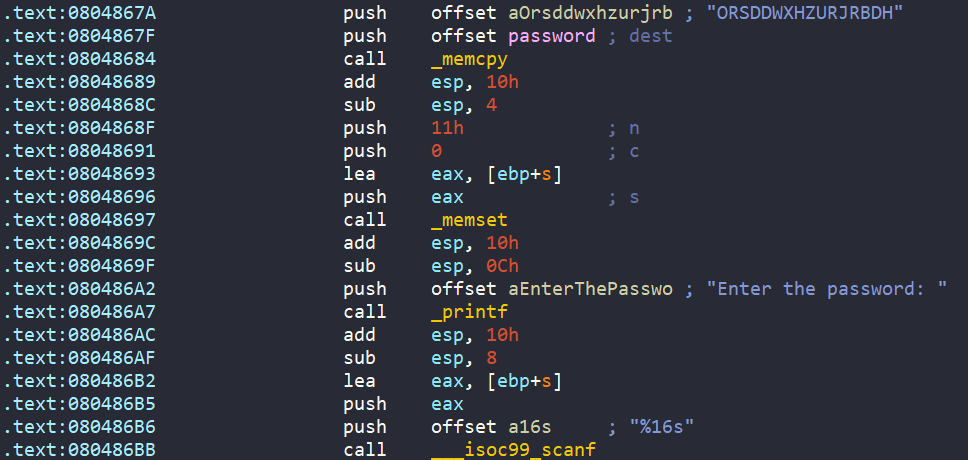
Next, ebp+s undergoes a loop, where each character is encoded by complex_function if they are in range [A-Z].
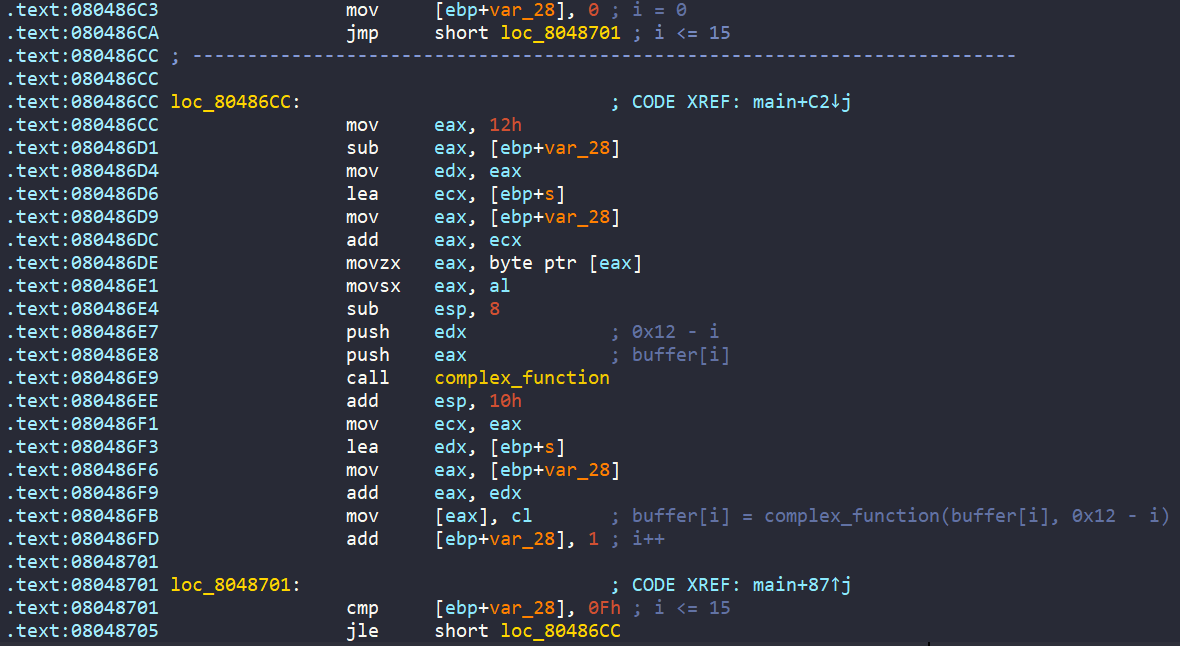

Finally, the encoded input is passed into check_equals_ORSDDWXHZURJRBDH to check if we can get the success message or not.

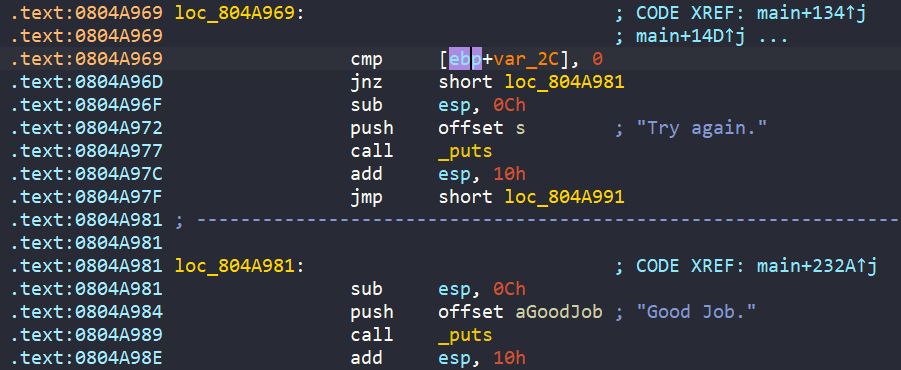
At this moment, we know that we can hook check_equals_ORSDDWXHZURJRBDH and read input from stdin to get flag. However, in this challenge, we play around with a new technique, which is called SimProcedure. Like the name suggests, this creates a symbolic function for an actual function in our program. This is initially used for hooking functions from libraries like strcmp, malloc, …, but we can use this to any functions, even one in our target program. By using a SimProcedure, we 8replace the actual function with a symbolic version that we control*. When angr sees that function call, it will run our version instead.
You can read further information from the links below:
- https://docs.angr.io/en/latest/extending-angr/simprocedures.html#quick-start↗
- https://docs.angr.io/en/latest/api.html#angr.SimProcedure↗
Build the script
Initially, we import necessary libraries, use LOGGING INFO and IPython debugging view.
import angr
import logging
import claripy
import sys
logging.getLogger("angr").setLevel(logging.INFO)
def hook(l=None):
if l:
locals().update(l)
import IPython
IPython.embed(banner1='', exit_msg='', confirm_exit=False)
exit(0)Next, we create angr project and SimProcedure to replace check_equals_ORSDDWXHZURJRBDH in our binary.
proj = angr.Project("../problems/10_angr_simprocedures")
# SimProcedure
class ReplaceCheckEqual(angr.SimProcedure):
def run(self, input_addr, len):
input = self.state.memory.load(input_addr, len)
password = "ORSDDWXHZURJRBDH"
return claripy.If(
input == password,
claripy.BVV(1, 32), # true
claripy.BVV(0, 32) # false
)
check_equal_symbol = "check_equals_ORSDDWXHZURJRBDH"
proj.hook_symbol(check_equal_symbol, ReplaceCheckEqual())Finally, we start our Simulation Manager to find the success message in the binary.
def success_message(state):
return b"Good Job." in state.posix.dumps(sys.stdout.fileno())
def failure_message(state):
return b"Try again." in state.posix.dumps(sys.stdout.fileno())
# Create init_state and prepare simulation
init_state = proj.factory.entry_state()
simulation = proj.factory.simgr(init_state)
simulation.explore(find=success_message, avoid=failure_message)
hook(locals()) # Open IPythonRun with IPython, we get the solution.


Solution
10_angr_simprocedures Final Script
import angr
import logging
import claripy
import sys
logging.getLogger("angr").setLevel(logging.INFO)
def hook(l=None):
if l:
locals().update(l)
import IPython
IPython.embed(banner1='', exit_msg='', confirm_exit=False)
exit(0)
def success_message(state):
return b"Good Job." in state.posix.dumps(sys.stdout.fileno())
def failure_message(state):
return b"Try again." in state.posix.dumps(sys.stdout.fileno())
def main():
proj = angr.Project("../problems/10_angr_simprocedures")
# -------------------------------- IDEA ----------------------------------
# We create a SimProcedure to hook the function check_equals_ORSDDWXHZURJRBDH()
# For further reading, please checking those docs out :D
# 1. https://docs.angr.io/en/latest/extending-angr/simprocedures.html#quick-start
# 2. https://docs.angr.io/en/latest/api.html#angr.SimProcedure
# --------------------------------- SOLUTION -----------------------------
# Create init_state
init_state = proj.factory.entry_state()
# Create SimProcedure
class Sim_Procedure_Replace_Check(angr.SimProcedure):
# Arguments "user_data_addr" and "length" come from
# the function that we hook, in this case is check_equals_ORSDDWXHZURJRBDH()
def run(self, user_data_addr, length):
# Load user_data from memory
load_user_data = self.state.memory.load(user_data_addr, length)
# Hard-coded password
hard_coded_password = "ORSDDWXHZURJRBDH"
# Return value
return claripy.If(
load_user_data == hard_coded_password,
claripy.BVV(1, 32), # true
claripy.BVV(0, 32) # false
)
check_equals_symbol = "check_equals_ORSDDWXHZURJRBDH"
proj.hook_symbol(check_equals_symbol, Sim_Procedure_Replace_Check())
# Prepare simulation and explore the success path
simulation = proj.factory.simgr(init_state)
simulation.explore(find=success_message, avoid=failure_message)
# NOT FOUND
if not simulation.found:
print("NOT FOUND")
hook(locals())
# FOUND => concretize to get the password
for solution_state in simulation.found:
print("Flag: ", solution_state.posix.stdin.concretize())
if __name__=="__main__":
main()11_angr_sim_scanf
Analyze the Binary
In main, we have a char array named s with a size of 20 bytes. Then a call to memset to clear everything at the address of s, and copy the string SUQMKQFX into that array s.
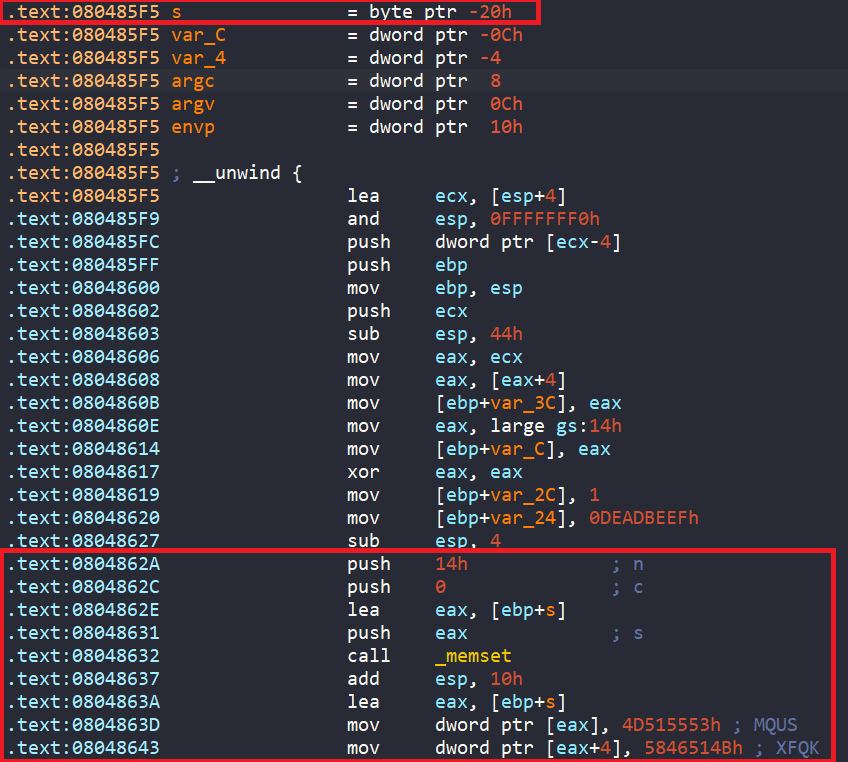
Then array s goes through a for loop, where each character in range [A-Z] is encoded.

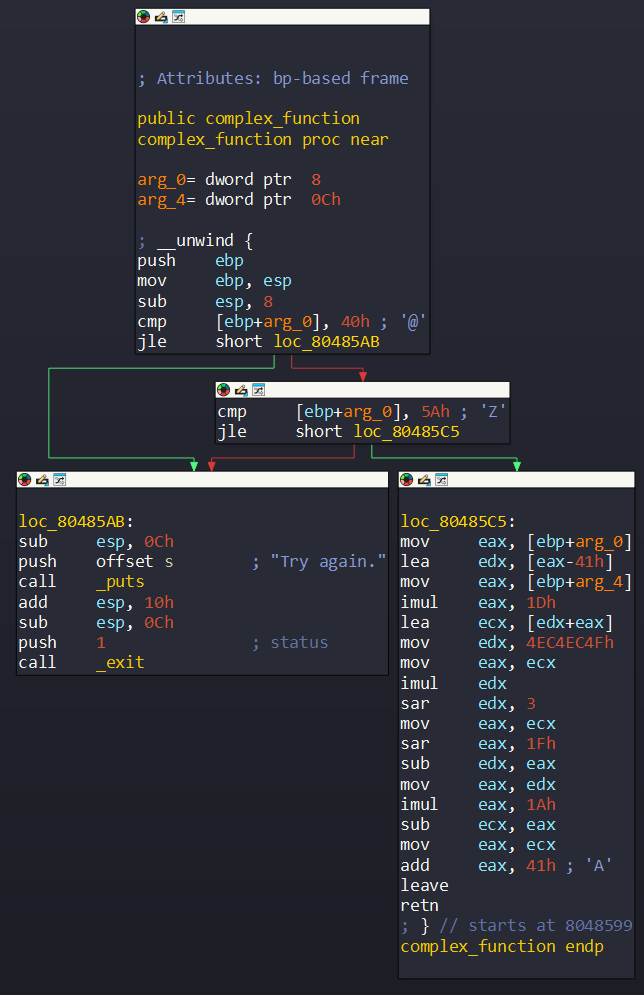
Next, we are asked to enter two unsigned integer into buffer0 and buffer1 in the .bss section.
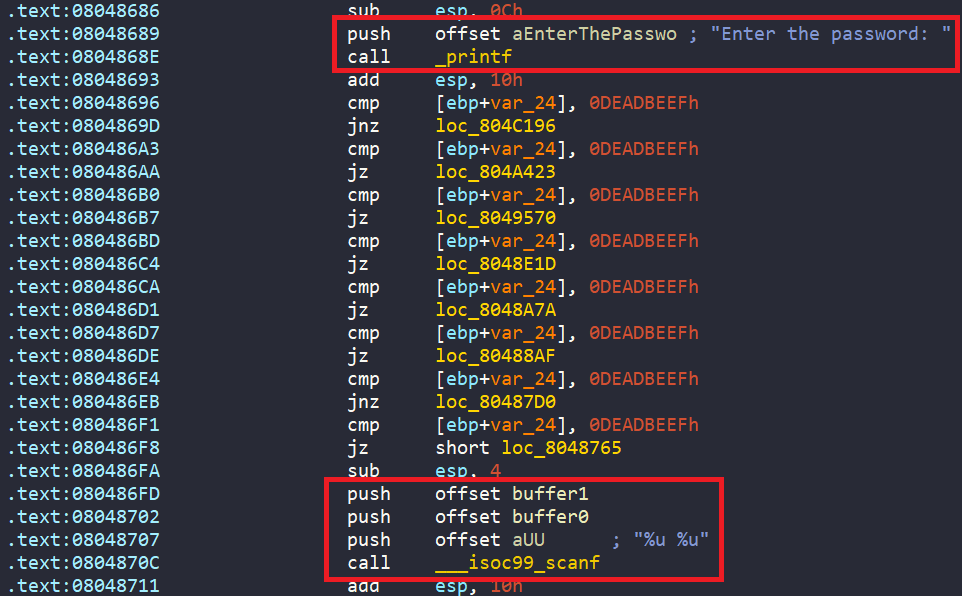


There is also a check to see if scanf is not successful, it prints “Try again.”



Finally, it compares buffer0 with encoded s and buffer1 with encoded s[4]. If both the comparisions are equal, it prints success message “Good Job.”
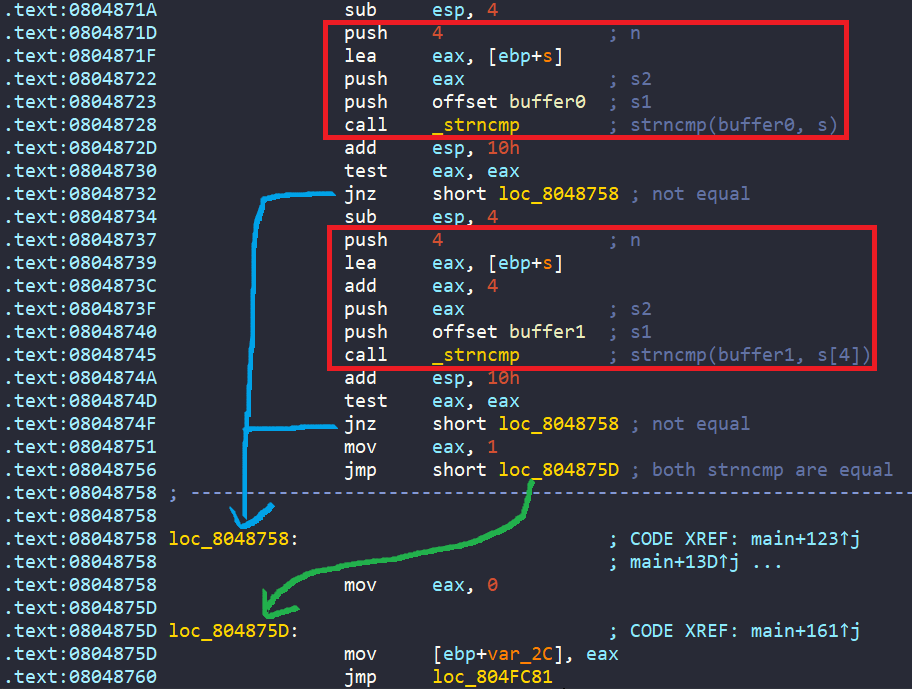
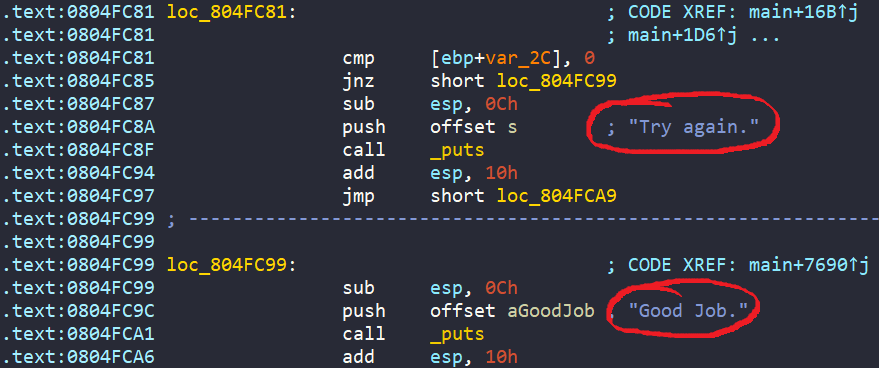
In general, our endgoal is to get “Good Job.” string. This happens only if two comparisons are true, buffer0 must match s, and buffer1 must match s[4].
The string s is hardcoded in the program and then encoded by a function called complex_function, so we can’t change it. But we can control buffer0 and buffer1, which are inputs.
To solve this with angr, we’ll make buffer0 and buffer1 symbolic inputs, which means angr will figure out what values they need to be. We can do this by using SimScanf, which lets us simulate input from the user.
Build the script
Let’s import necessary libraries, use LOGGING INFO and IPython debugging view.
import angr
import logging
import claripy
import sys
logging.getLogger("angr").setLevel(logging.INFO)
def hook(l=None):
if l:
locals().update(l)
import IPython
IPython.embed(banner1='', exit_msg='', confirm_exit=False)
exit(0)Next, we create angr project and SimScanf.
proj = angr.Project("../problems/11_angr_sim_scanf")
# SimProcedure to replace scanf
class ReplaceScanf(angr.SimProcedure):
def run(self, format_string, addr1, addr2):
# Create 2 symbolic variables for our input
size_in_bytes = 0x4
password1 = claripy.BVS("password1", size_in_bytes*8)
password2 = claripy.BVS("password2", size_in_bytes*8)
# Write the 2 symbolic variables into memory
# Since we are writing number into address => remember endianness
self.state.memory.store(addr1, password1, endness=proj.arch.memory_endness)
self.state.memory.store(addr2, password2, endness=proj.arch.memory_endness)
# Store 2 symbolic variables into global "dict"
# so that we can reference it outside the SimProcedure
self.state.globals["solutions"] = (password1, password2)
scanf_symbol = "__isoc99_scanf"
proj.hook_symbol(symbol_name=scanf_symbol, simproc=ReplaceScanf())Finally, we create Simulation Manager to find “Good Job.” string.
# Create entry state
init_state = proj.factory.entry_state()
def success_message(state):
return b"Good Job." in state.posix.dumps(sys.stdout.fileno())
def failure_message(state):
return b"Try again." in state.posix.dumps(sys.stdout.fileno())
# Prepare simulation
simulation = proj.factory.simgr(init_state)
simulation.explore(find=success_message, avoid=failure_message)
# NOT FOUND
if not simulation.found:
print("NOT FOUND")
hook(locals())
for solution_state in simulation.found:
real_password = solution_state.globals["solutions"]
print("Flag", solution_state.solver.eval(real_password[0]), solution_state.solver.eval(real_password[1]))Run the script and we got the passwords.

Solution
11_angr_sim_scanf Final Script
import angr
import logging
import claripy
import sys
logging.getLogger("angr").setLevel(logging.INFO)
def hook(l=None):
if l:
locals().update(l)
import IPython
IPython.embed(banner1='', exit_msg='', confirm_exit=False)
exit(0)
def success_message(state):
return b"Good Job." in state.posix.dumps(sys.stdout.fileno())
def failure_message(state):
return b"Try again." in state.posix.dumps(sys.stdout.fileno())
def main():
proj = angr.Project("../problems/11_angr_sim_scanf")
# SimProcedure to replace scanf
class ReplaceScanf(angr.SimProcedure):
def run(self, format_string, addr1, addr2):
# Create 2 symbolic variables for our input
size_in_bytes = 0x4
password1 = claripy.BVS("password1", size_in_bytes*8)
password2 = claripy.BVS("password2", size_in_bytes*8)
# Write the 2 symbolic variables into memory
# Since we are writing number into address => remember endianness
self.state.memory.store(addr1, password1, endness=proj.arch.memory_endness)
self.state.memory.store(addr2, password2, endness=proj.arch.memory_endness)
# Store 2 symbolic variables into global "dict"
# so that we can reference it outside the SimProcedure
self.state.globals["solutions"] = (password1, password2)
scanf_symbol = "__isoc99_scanf"
proj.hook_symbol(symbol_name=scanf_symbol, simproc=ReplaceScanf())
# Create entry state
init_state = proj.factory.entry_state()
# Prepare simulation
simulation = proj.factory.simgr(init_state)
simulation.explore(find=success_message, avoid=failure_message)
# NOT FOUND
if not simulation.found:
print("NOT FOUND")
hook(locals())
for solution_state in simulation.found:
real_password = solution_state.globals["solutions"]
print("Flag", solution_state.solver.eval(real_password[0]), solution_state.solver.eval(real_password[1]))
if __name__=="__main__":
main()12_angr_veritesting
Overview
This challenge is short and straightforward, so I’ll give a quick explanation of why I chose a certain approach.
In the main pseudo-code, we are asked to enter a 32-byte string, which gets stored at v19 + 3. After that, the program enters a for loop that runs 32 times.

This kind of loop causes a state explosion in angr, meaning angr creates a huge number of possible paths to explore, which slows everything down.
To deal with this, we can use a technique in angr called veritesting. Veritesting works on the Program Counter (PC). It merges different paths that end up at the same PC, effectively reducing the number of states angr has to explore. This saves time and makes the analysis much faster.
Solution
12_angr_veritesting Final Script
import angr
import logging
import sys
logging.getLogger("angr").setLevel(logging.INFO)
def hook(l=None):
if l:
locals().update(l)
import IPython
IPython.embed(banner1='', exit_msg='', confirm_exit=False)
exit(0)
def success_message(state):
return b"Good Job." in state.posix.dumps(sys.stdout.fileno())
def failure_message(state):
return b"Try again." in state.posix.dumps(sys.stdout.fileno())
def main():
proj = angr.Project("../problems/12_angr_veritesting")
# Create init_state
# LAZY_SOLVES => Explore more new states, prevent spending in one state for too long
init_state = proj.factory.entry_state(add_options={
angr.options.LAZY_SOLVES
})
# Prepare simulation
# Need veritesting => because of this:
# for ( i = 0; i <= 31; ++i )
# {
# v3 = *((char *)v19 + i + 3);
# if ( v3 == complex_function(75, i + 93) )
# ++v15;
# }
#
# Would take exponentially states for each True and False branch!
simulation = proj.factory.simgr(init_state, veritesting=True)
simulation.explore(find=success_message, avoid=failure_message)
# NOT FOUND
if not simulation.found:
print("NOT FOUND")
hook(locals())
# FOUND => concretize stdin
for solution_state in simulation.found:
print(solution_state.posix.stdin.concretize())
if __name__=="__main__":
main()13_angr_static_binary
Overview
We can clearly see that this binary is statically linked. This means all the necessary libraries have been compiled directly into the binary itself, it does not rely on any dynamic libraries at runtime.

But why we need to care about this?
In angr, there’s a feature called SimProcedure. It replaces common functions from dynamic libraries (like printf, scanf, malloc, etc.) with angr predefined versions to speed up analysis.
However, in a statically linked binary, those functions are no longer external, they’re compiled into the binary as raw assembly. That means angr can’t replace them with SimProcedures and has to run the actual instructions instead.
So when working with statically linked binaries, we have longer analysis time and possibly more manual effort when dealing with functions that would normally be handled by SimProcedures.
Analyze the Binary
In main, first of all, we clear everything up for variable ebp+s2, then load the string PYIEFPIC into ebp+s2.
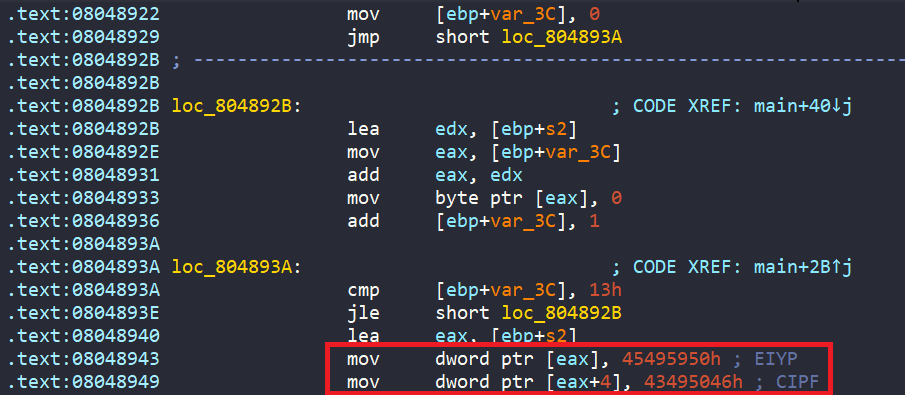
After that, we are asked to enter an 8-byte string into ebp+s1, and each character from ebp+s1 is being encoded by complex_function if they are in range [A-Z].
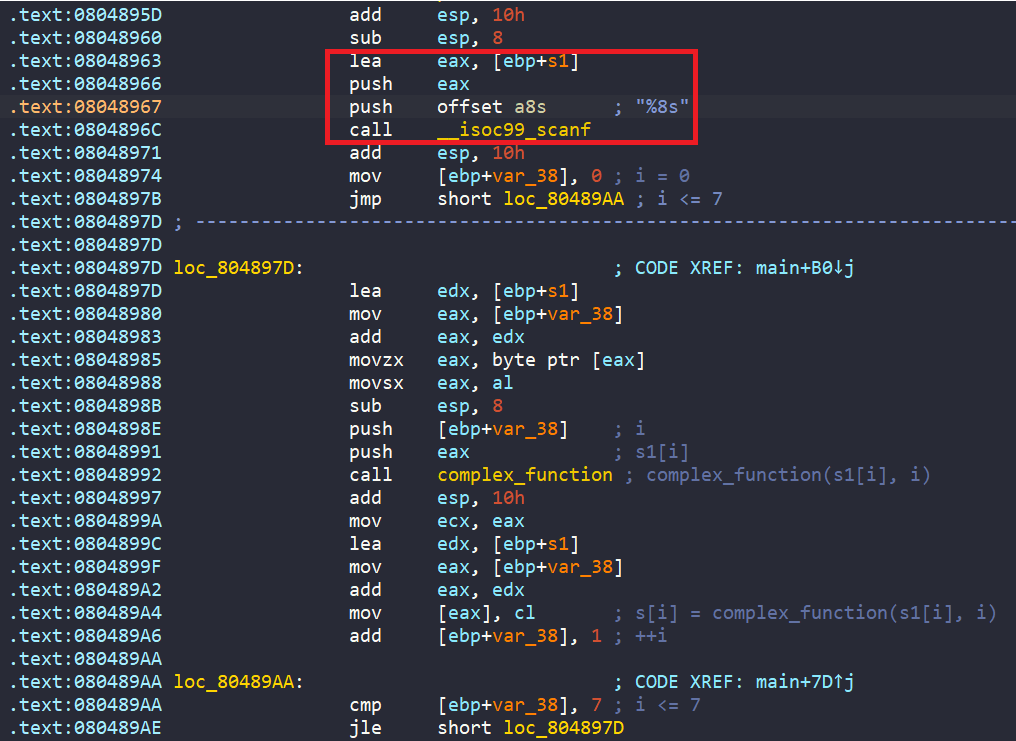

Finally, we have a comparision between ebp+s1 and ebp+s2. If both are equal, we get the success message “Good Job.”

Our goal is to reach the message “Good Job.” Since this binary is statically linked, functions like printf, scanf, and puts are compiled directly into it, so angr can’t use SimProcedures by default.
Also, the program starts from _start, which calls _libc_start_main before reaching main. This adds unnecessary pressure in symbolic execution.
To speed up analysis, we should hook these four functions: _libc_start_main, printf, scanf, and puts. This lets angr skip their internal logic and focus on the real challenge logic.
Build the script
First of all, let’s import necessary libraries, use LOGGING INFO and IPython debugging view.
import angr
import logging
import sys
logging.getLogger("angr").setLevel(logging.INFO)
def hook(l=None):
if l:
locals().update(l)
import IPython
IPython.embed(banner1='', exit_msg='', confirm_exit=False)
exit(0)Next, we create angr project and start hooking functions.
proj = angr.Project("../problems/13_angr_static_binary")
printf_addr = 0x0804ED40
scanf_addr = 0x0804ED80
puts_addr = 0x0804F350
__libc_start_main_addr = 0x08048D10
proj.hook(printf_addr, angr.SIM_PROCEDURES['libc']['printf']())
proj.hook(scanf_addr, angr.SIM_PROCEDURES['libc']['scanf']())
proj.hook(puts_addr, angr.SIM_PROCEDURES['libc']['puts']())
proj.hook(__libc_start_main_addr, angr.SIM_PROCEDURES["glibc"]["__libc_start_main"]())Finally, we prepare Simulation Manager to find the success message “Good Job.”
init_state = proj.factory.entry_state()
simulation = proj.factory.simgr(init_state)
def success_message(state):
return b"Good Job." in state.posix.dumps(sys.stdout.fileno())
def failure_message(state):
return b"Try again." in state.posix.dumps(sys.stdout.fileno())
simulation.explore(find=success_message, avoid=failure_message)
if not simulation.found:
print("NOT FOUND")
hook(locals())
for solution_state in simulation.found:
print(solution_state.posix.stdin.concretize())
hook(locals()) # Open IPythonRun the script and we get the flag!

Solution
13_angr_static_binary Final Script
import angr
import logging
import sys
logging.getLogger("angr").setLevel(logging.INFO)
def hook(l=None):
if l:
locals().update(l)
import IPython
IPython.embed(banner1='', exit_msg='', confirm_exit=False)
exit(0)
def success_message(state):
return b"Good Job." in state.posix.dumps(sys.stdout.fileno())
def failure_message(state):
return b"Try again." in state.posix.dumps(sys.stdout.fileno())
def main():
proj = angr.Project("../problems/13_angr_static_binary")
# "libc" functions address linked in the STATIC BINARY
# (strncmp is in PLT section) => No need to find the address
printf_addr = 0x0804ED40
scanf_addr = 0x0804ED80
puts_addr = 0x0804F350
# "glibc" function address linked in the STATIC BINARY
__libc_start_main_addr = 0x08048D10
# HOOK "libc" and "glibc" functions to SimProcedures in ANGR
#
# Remember the "()" at the end of each SimProcedures
# - Without "()" it just points out where the function is in SimProcedure,
# not creating an instance of that function from SimProcedure
# - With "()", creating an instace from SimProcedure and overwrite it into memory
proj.hook(printf_addr, angr.SIM_PROCEDURES["libc"]["printf"]())
proj.hook(scanf_addr, angr.SIM_PROCEDURES["libc"]["scanf"]())
proj.hook(puts_addr, angr.SIM_PROCEDURES["libc"]["puts"]())
proj.hook(__libc_start_main_addr, angr.SIM_PROCEDURES["glibc"]["__libc_start_main"]())
# Create init_state
init_state = proj.factory.entry_state()
# Prepare simulation
simulation = proj.factory.simgr(init_state)
simulation.explore(find=success_message, avoid=failure_message)
# NOT FOUND
if not simulation.found:
print("NOT FOUND")
hook(locals())
# FOUND => concretize the input
for solution_state in simulation.found:
print("Flag: ", solution_state.posix.stdin.concretize())
if __name__=="__main__":
main()14_angr_shared_library
Analyze the Binary
In this challenge, we are provided two binaries, 14_angr_shared_library and lib14_angr_shared_library.so.
The main function from the binary 14_angr_shared_library is short and simple. It basically asks us to enter an 8-byte string password and passes it into validate function.

However, the validate function is an external function from lib14_angr_shared_library.

This is the pseudo-code of validate function.
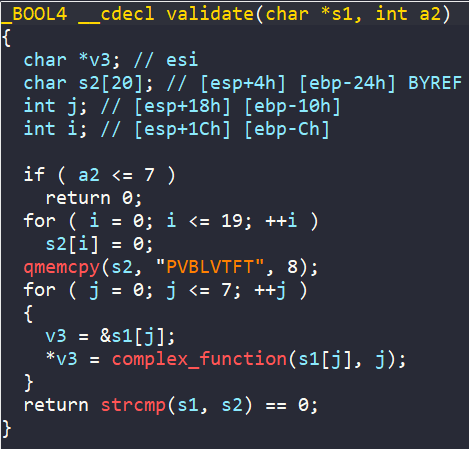
It is loading the string PVBLVTFT into s2, then each character of our input is encoded by complex_function if they are in range [A-Z].
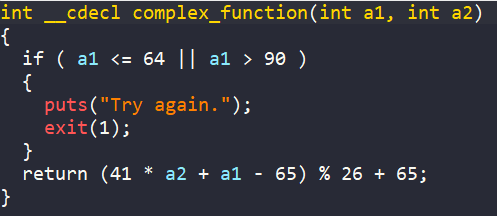
The idea here is to load the library ".so" with a fake base address.
Then from the base address, we will find the address of function validate(), which can be interpreted as:
Rememeber that the arguments of validate(), it contains the input password. So we can basically create a symbolic variable and let angr find that for us :D
Build the script
As usual, let’s import necessary libraries, use LOGGING INFO and IPython debugging view.
import angr
import logging
import claripy
logging.getLogger("angr").setLevel(logging.INFO)
def hook(l=None):
if l:
locals().update(l)
import IPython
IPython.embed(banner1='', exit_msg='', confirm_exit=False)
exit(0)Next, we load the ".so" library with a fake base address.
base = 0x40000000 # Fake base address :>
proj = angr.Project(
"../problems/lib14_angr_shared_library.so",
load_options={
'main_opts' : {
'custom_base_addr' : base
}
}
)Based on this function format _BOOL4 __cdecl validate(char *s1, int a2).
We must create a pointer pointing to a fake address (*s1) and the length (a2).
validate_addr = base + 0x6D7
buffer_pointer = claripy.BVV(0x90000000, 32) # act as a pointer to the later symbolic password
length = claripy.BVV(0x8, 32)Now, our state will start from validate function because inside validate, (*s1) is actually our password. So just create a symbolic variable for (*s1) and we are done :D
This means that we can create a symbolic variable linked to the pointer (buffer_pointer).
# This is like a function call => validate(char *s1, int a2)
init_state = proj.factory.call_state(validate_addr, buffer_pointer, length)Now, we will create symbolic password, where it is stored into the buffer_pointer.
size_in_bytes = 0x8
password = claripy.BVS("password", size_in_bytes*8)
# Write symbolic password into buffer_pointer
init_state.memory.store(buffer_pointer, password)After finishing the set up, we can start our simulation. But where should our simulation explore?
⇒ The smart thing is that we explore to the end of validate() and put a constraint for only the True.
⇒ angr will discard those “password” that doesn’t match the True :>
Then concretize the password (symbolic variable).
simulation = proj.factory.simgr(init_state)
check_point_addr = base + 0x783 # the end of validate()
simulation.explore(find=check_point_addr)
# NOT FOUND
if not simulation.found:
print("NOT FOUND")
hook(locals())
# FOUND => Add constraint to get the "password" for the True
for solution_state in simulation.found:
# Add constraint that the function return must be true
solution_state.add_constraints(solution_state.regs.eax != 0)
solution_password = solution_state.solver.eval(password, cast_to=bytes)
print("Flag: ", solution_password)This is the result we get.

Solution
14_angr_shared_library Final Script
import angr
import logging
import claripy
logging.getLogger("angr").setLevel(logging.INFO)
def hook(l=None):
if l:
locals().update(l)
import IPython
IPython.embed(banner1='', exit_msg='', confirm_exit=False)
exit(0)
def main():
# ------------------------------ IDEA ----------------------------
#
# The idea here is to load the library ".so" with a fake base address.
#
# Then from the base address, we will find the address of function
# validate(), which can be interpreted as: "base + offset"
#
# Rememeber that the arguments off validate(), it contains the input password
# So we can basically create a symbolic variable and let ANGR find that for us :D
# ----------------------------- SOLUTION --------------------------
# Load the ".so" library
base = 0x40000000 # Fake base address :>
proj = angr.Project(
"../problems/lib14_angr_shared_library.so",
load_options={
'main_opts' : {
'custom_base_addr' : base
}
}
)
# Based on the function format:
# _BOOL4 __cdecl validate(char *s1, int a2)
#
# We must create an fake address (*s1), the length (a2)
# and address of validate = base + offset
validate_addr = base + 0x6D7
buffer_pointer = claripy.BVV(0x90000000, 32) # act as a pointer to the later symbolic password
length = claripy.BVV(0x8, 32)
# Here is the key:
# Our state will start from the call to function validate()
# because inside validate(), (*s1) is actually our password
# => just create the symbolic variable for (*s1) and we are done :D
# This means that we can create a symbolic variable linked to the pointer (buffer_pointer)
# This is like a function call => validate(char *s1, int a2)
init_state = proj.factory.call_state(validate_addr, buffer_pointer, length)
# Now, we will create symbolic password, where it is stored into the buffer_pointer
size_in_bytes = 0x8
password = claripy.BVS("password", size_in_bytes*8)
# Write symbolic password into buffer_pointer
init_state.memory.store(buffer_pointer, password)
# After finishing the set up, we can start our simulation
# But where should our simulation explore?
#
# => The smart thing is that we explore to the end of validate()
# and put a constraint for only the True => ANGR will discard those "password"
# that doesn't match the True :>
#
# Then concretize the password (symbolic variable) :P
simulation = proj.factory.simgr(init_state)
check_point_addr = base + 0x783 # the end of validate()
simulation.explore(find=check_point_addr)
# NOT FOUND
if not simulation.found:
print("NOT FOUND")
hook(locals())
# FOUND => Add constraint to get the "password" for the True
for solution_state in simulation.found:
# Add constraint that the function return must be true
solution_state.add_constraints(solution_state.regs.eax != 0)
solution_password = solution_state.solver.eval(password, cast_to=bytes)
print("Flag: ", solution_password)
if __name__=="__main__":
main()15_angr_arbitrary_read
Analyze the Binary
Here is the pseudo-code of main in binary 15_angr_arbitrary_read.
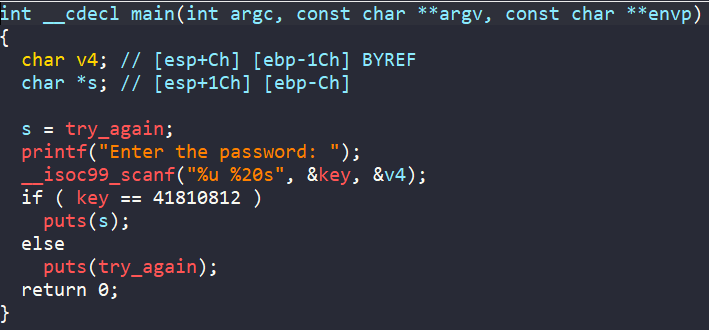
Clearly, at scanf(), there is vulnerability where v4 is of type “char” (4 bytes), but we are reading input of 20 bytes “%20s”. This is a type of OVERFLOW.
If we look closely, v4 is at ebp-0x1C, and *s is at ebp-0xC.
[ebp - 0x0C] <-- s
[ebp - 0x10]
[ebp - 0x14]
[ebp - 0x18]
[ebp - 0x1C] <-- v4This means, if we write 20 bytes, then *s will be overwritten. Look at the pseudo-code, it is obvious that *s will always be “try_again”, which prints the string “Try Again.”
But what if we overwrite it with the string “Good Job.”? :D
That is greate, and to make your exploit faster, angr will help us finding the value of 2 input variables (key and v4).
So our strategy with angr is as follow:
- Determine whether the argument for “puts” is controlled by user or not. If yes, we can set the argument to be the location of “Goob Job.” string.
- Search for the call of “puts”, which will be exploited to print “Good Job.”
- Solve the symbolic input to get the solution
Build the script
Let’s add necessary libraries, use LOGGING INFO and IPython debugging view. Also, create angr project and prepare initial state from scratch.
import angr
import logging
import claripy
logging.getLogger("angr").setLevel(logging.INFO)
def hook(l=None):
if l:
locals().update(l)
import IPython
IPython.embed(banner1='', exit_msg='', confirm_exit=False)
exit(0)
proj = angr.Project("../problems/15_angr_arbitrary_read")
init_state = proj.factory.entry_state()Since the input that we want to read is from __isoc99_scanf("%u %20s", &key, &v4);, which is a number %u and a string %20s, let’s create a SimProcedure to create symbolic variable for these two inputs!
class ReplaceScanf(angr.SimProcedure):
def run(self, format_string, arg0_addr, arg1_addr):
arg0 = claripy.BVS("arg0", 4*8)
arg1 = claripy.BVS("arg1", 20*8)
for char in arg1.chop(bits=8):
self.state.add_constraints(char >= '0', char <= 'z')
self.state.memory.store(arg0_addr, arg0, endness=proj.arch.memory_endness)
self.state.memory.store(arg1_addr, arg1)
self.state.globals['solution0'] = arg0
self.state.globals['solution1'] = arg1
scanf_symbol = "__isoc99_scanf"
proj.hook_symbol(scanf_symbol, ReplaceScanf())Then, we need to check whether puts argument is controlled by user or not, which means it can be overflowed by the string input %20s.
[ebp - 0x0C] <-- s
[ebp - 0x10]
[ebp - 0x14]
[ebp - 0x18]
[ebp - 0x1C] <-- v4 (string input %20s)def check_puts(state):
puts_argument = state.memory.load(state.regs.esp + 4, 4, endness=proj.arch.memory_endness)
if state.solver.symbolic(puts_argument):
good_job_addr = 0x484F4A47 # good job string address
copied_state = state.copy()
copied_state.add_constraints(puts_argument == good_job_addr)
if(copied_state.satisfiable()):
state.add_constraints(puts_argument == good_job_addr)
return True
else:
return False
else:
return False
def success(state):
puts_addr = 0x08048370 # put .plt section address
if(state.addr == puts_addr):
return check_puts(state)
else:
return FalseFinally, let’s create Simulation Manager to find the success state, where the puts function prints the success message “Good Job.”
simulation = proj.factory.simgr(init_state)
simulation.explore(find=success)
if not simulation.found:
print("NOT FOUND")
hook(locals())
for solution_state in simulation.found:
scanf_arg0 = solution_state.solver.eval(solution_state.globals['solution0'])
scanf_arg1 = solution_state.solver.eval(solution_state.globals['solution1'], cast_to=bytes)
print("Flag:", scanf_arg0, scanf_arg1)Solution
15_angr_arbitrary_read Final Script
# Here is the pseudo-code of main from IDA Pro
#
# int __cdecl main(int argc, const char **argv, const char **envp)
# {
# char v4; // [esp+Ch] [ebp-1Ch] BYREF
# char *s; // [esp+1Ch] [ebp-Ch]
#
# s = try_again;
# printf("Enter the password: ");
# __isoc99_scanf("%u %20s", &key, &v4);
# if ( key == 41810812 )
# puts(s);
# else
# puts(try_again);
# return 0;
# }
#
# Clearly, at scanf(), there is vulnerability where v4 is of type "char" (4 bytes),
# but we are reading input of 20 bytes "%20s". This is a type of OVERFLOW
#
# If we look closely, v4 is at ebp-0x1C, and *s is at ebp-0xC.
# [ebp - 0x0C] <-- s
# [ebp - 0x10]
# [ebp - 0x14]
# [ebp - 0x18]
# [ebp - 0x1C] <-- v4
# This means, if we write 20 bytes, then *s will be overwritten.
# Look at the pseudo-code, it is obvious that *s will always be "try_again",
# which prints the string "Try Again."
# But what if we overwrite it with the string "Good Job."? :D
#
# That is greate, and to make your exploit faster, angr will help us finding
# the value of 2 input variables (key and v4).
#
# So our strategy with angr is as follow:
# 1) Determine whether the argument for "puts" is controlled by user or not.
# If yes, we can set the argument to be the location of "Goob Job." string.
# 2) Search for the call of "puts", which will be exploited to print "Good Job."
# 3) Solve the symbolic input to get the solution
import angr
import logging
import claripy
logging.getLogger('angr').setLevel(logging.INFO)
def hook(l=None):
if l:
locals().update(l)
import IPython
IPython.embed(banner1='', exit_msg='', confirm_exit=False)
exit(0)
def main():
proj = angr.Project("../problems/15_angr_arbitrary_read")
init_state = proj.factory.entry_state()
# First of all, let's create a SimProcedure for scanf(), as well as
# the symbolic variables for scanf() arguments.
class ReplaceScanf(angr.SimProcedure):
def run(self, format_string, arg0_addr, arg1_addr):
password0 = claripy.BVS("password0", 4*8) # %u
password1 = claripy.BVS("password1", 20*8) # %20s
# With password1, we should make sure each character is printable.
# We can still leave it raw, and get the solution, but it contains
# character that we can't copy, paste, or even type into terminal.
# So... Why put ourselves into the deadend? :D
for char in password1.chop(bits=8):
self.state.add_constraints(char >= '0', char <= 'z')
# Remember, with numbers, when storing into memory,
# we have to consider the "endianess"
self.state.memory.store(arg0_addr, password0, endness=proj.arch.memory_endness)
self.state.memory.store(arg1_addr, password1)
self.state.globals['solution0'] = password0
self.state.globals['solution1'] = password1
scanf_symbol = "__isoc99_scanf"
proj.hook_symbol(scanf_symbol, ReplaceScanf())
# The next thing to do is checking whether arguments passed into "puts"
# can be controlled by user or not.
#
# The term "controlled by user" means that depends on user input,
# the argument passed into "puts" can be changed. Like in our case:
# if ( key == 41810812 )
# puts(s);
# else
# puts(try_again);
# With different value of "key", arguments for "puts" can be "s" or "try_again"
def check_puts(state):
# Here is how the stack looks like when "puts" is called:
#
# esp + 7 -> /----------------\
# esp + 6 -> | puts |
# esp + 5 -> | parameter |
# esp + 4 -> \----------------/
# esp + 3 -> /----------------\
# esp + 2 -> | return |
# esp + 1 -> | address |
# esp -> \----------------/
# Since argument for "puts" are pointer to string, which means it
# is address => we have to consider endianess
puts_argument = state.memory.load(state.regs.esp + 4, 4, endness=proj.arch.memory_endness)
if state.solver.symbolic(puts_argument):
good_job_addr = 0x484F4A47
copied_state = state.copy()
copied_state.add_constraints(puts_argument == good_job_addr)
if(copied_state.satisfiable()):
state.add_constraints(puts_argument == good_job_addr)
return True
else:
return False
else:
return False
# Now, let's search for call of "puts"
simulation = proj.factory.simgr(init_state)
def success(state):
puts_addr = 0x08048370
if(state.addr == puts_addr):
return check_puts(state)
else:
return False
simulation.explore(find=success)
# NOT FOUND
if not simulation.found:
print("NOT FOUND")
hook(locals())
for solution_state in simulation.found:
solution0 = solution_state.solver.eval(solution_state.globals['solution0'])
solution1 = solution_state.solver.eval(solution_state.globals['solution1'], cast_to=bytes)
print("Flag:", solution0, solution1)
if __name__=="__main__":
main()16_angr_arbitrary_write
Analyze the Binary
Here is the pseudo-code of main.
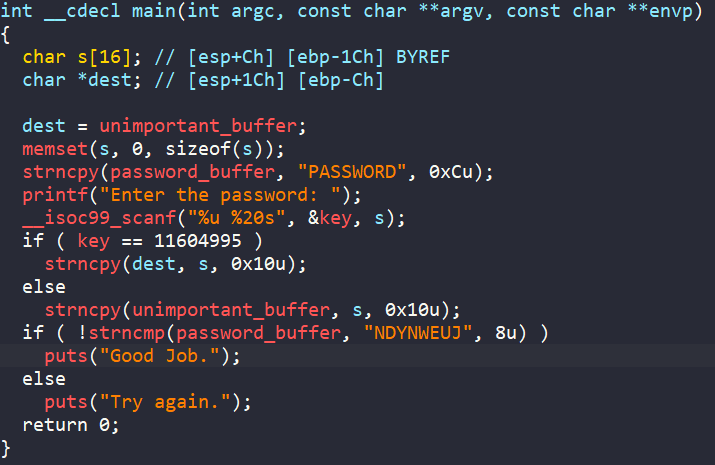
Look at the pseudo-code, we can easily see that it will always print “Try again.” since our input s is written to dest, or unimportant_buffer based on the key value.
So, can we make password_buffer equal to NDYNWEUJ? That’s seem impossible right!?
Well, the answer is yes! :> → With the help of angr
Here’s why:
- Look at this:
__isoc99_scanf("%u %20s", &key, s);
We can see that we are entering an input of 20 bytes into
s. Furthermore,sis atebp-0x1c, and*destis atebp-0xc.[ebp - 0x0C] <-- *dest [ebp - 0x10] [ebp - 0x14] [ebp - 0x18] [ebp - 0x1C] <-- sClearly, we can overflow
*destwithsby providing a 20-byte input.
→ With angr, we can make s contains arbitrary data, then add a CONSTRAINT to make it include NDYNWEUJ.
- But, we have another problem where
*destdoesn’t point topassword_buffer.
- Luckily, we have angr, we can symbolically control
*destto make it point to the address ofpassword_buffer, using a constraint.
→ The idea is to write arbitrary data (source contents) into arbitrary location (destination pointer)
And our idea perfectly fits the working of strncpy() function, where it writes content of source into destination address.
strncpy(destination_pointer, source_contents);When strncpy() is called, we can:
- Control the source contents (not the source pointer!)
- This will allow us to write arbitrary data to the destination.
- Control the destination pointer
- This will allow us to write to an arbitrary location.
→ “source contents” and “destination pointer” must be symbolic. This means it depends on user input, in this case is the value of key.
if ( key == 11604995 )
strncpy(dest, s, 0x10u);
else
strncpy(unimportant_buffer, s, 0x10u);Solution
Here is the solution for this challenge.
16_angr_arbitrary_write Final Script
import angr
import logging
import claripy
logging.getLogger("angr").setLevel(logging.INFO)
def hook(l=None):
if l:
locals().update(l)
import IPython
IPython.embed(banner1='', exit_msg='', confirm_exit=False)
exit(0)
def main():
proj = angr.Project("../problems/16_angr_arbitrary_write")
init_state = proj.factory.entry_state()
# SimProcedure for scanf
class ReplaceScanf(angr.SimProcedure):
def run(self, format_string, arg0_addr, arg1_addr):
arg0 = claripy.BVS("arg0", 4*8) # %u
arg1 = claripy.BVS("arg1", 20*8) # %20s
# Ensure arg1 contains printable characters
for char in arg1.chop(bits=8):
self.state.add_constraints(char >= '0', char <= 'z')
# Write symbolic variables into memory
self.state.memory.store(arg0_addr, arg0, endness=proj.arch.memory_endness)
self.state.memory.store(arg1_addr, arg1)
# Write to globals for reference
self.state.globals['solution0'] = arg0
self.state.globals['solution1'] = arg1
scanf_symbol = "__isoc99_scanf"
proj.hook_symbol(scanf_symbol, ReplaceScanf())
# Check if strncpy arguments are symbolic or not
def check_strncpy(state):
strncpy_dest = state.memory.load(state.regs.esp+4, 4, endness=proj.arch.memory_endness)
strncpy_src = state.memory.load(state.regs.esp+8, 4, endness=proj.arch.memory_endness)
strncpy_len = state.memory.load(state.regs.esp+12, 4, endness=proj.arch.memory_endness)
# Since strncpy_src is the pointer, but we need source content
# => Dereference it to get the source content!
src_content = state.memory.load(strncpy_src, strncpy_len)
# If dest pointer and source content is symbolic (depends on user input)
if state.solver.symbolic(strncpy_dest) and state.solver.symbolic(src_content):
password_buffer_addr = 0x57584344
hard_coded_string = "NDYNWEUJ"
destination_pointer_constraint = (strncpy_dest == password_buffer_addr)
source_content_constraint = (src_content[-1:-8*8] == hard_coded_string)
copied_state = state.copy()
copied_state.add_constraints(destination_pointer_constraint, source_content_constraint)
if(copied_state.satisfiable()):
state.add_constraints(destination_pointer_constraint, source_content_constraint)
return True
else:
return False
else:
return False
def success(state):
strncpy_addr = 0x08048410
if(state.addr == strncpy_addr):
return check_strncpy(state)
else:
return False
simulation = proj.factory.simgr(init_state)
simulation.explore(find=success)
if not simulation.found:
print("NOT FOUND")
hook(locals())
for solution_state in simulation.found:
solution0 = solution_state.solver.eval(solution_state.globals['solution0'])
solution1 = solution_state.solver.eval(solution_state.globals['solution1'], cast_to=bytes)
print("Flag:", solution0, solution1)
if __name__=="__main__":
main()
17_angr_arbitrary_jump
Analyze the Binary
Here is the pseudo-code of main from IDA.
int __cdecl main(int argc, const char **argv, const char **envp)
{
printf("Enter the password: ");
read_input();
puts("Try again.");
return 0;
}Here is the pseudo-code of read_input.
int read_input()
{
_BYTE v1[32]; // [esp+28h] [ebp-20h] BYREF
return __isoc99_scanf("%s", v1);
}→ This is a classic Buffer Overflow problem, where we will overwrite the return address (eip) of read_input() to the address of print_good() function.
To do this in angr, we perform an arbitrary jump, where we will make eip (instruction pointer) as a symbolic variable (can be controlled by user).
Then, we will include a constraint so that our symbolic variable (eip) must be equal to the address of print_good() function.
Why we say “symbolic variable can be controlled by user”?
Let’s have a look at the stack of
read_input():[ebp + 0x04] <-- return address of read_input() [ebp - 0x00] [ebp - 0x04] [ebp - 0x08] [ebp - 0x0C] [ebp - 0x10] [ebp - 0x14] [ebp - 0x18] [ebp - 0x1C] [ebp - 0x20] <-- v1[32]Clearly,
v1[32]has size of 32-byte→ When providing input “greater than 32-byte”, we will overwrite the return address.
Why can this be solved with angr?
→ With angr, we can suppose eip (return address) as symbolic, meaning it can contain any possible values, a.k.a
"uncontrained state".This means the program can jump to anywhere, and we will add a constraint to make “eip” equal to the address of
print_good(). However, by default, those “unconstrained states” will be discarded by angr, and we don’t want that to happen. So latter, we have a solution for this :>
So, basically, our strategy is as follow:
- Create symbolic variable for “eip”
- Ensure “unconstrained states” won’t be discarded
- When saying “unconstrained states”, this refers to symbolic “eip”.
- Whenever encounter symbolic “eip” (unconstrained states)
- Add a constraint to ensure “eip” equal to
print_good()address.
- Add a constraint to ensure “eip” equal to
Note:
We will define our “custom stashes” into Simulation Manager
→ Further reading: https://docs.angr.io/en/latest/core-concepts/pathgroups.html↗
Solution
17_angr_arbitrary_jump Final Script
import angr
import logging
import claripy
logging.getLogger("angr").setLevel(logging.INFO)
def hook(l=None):
if l:
locals().update(l)
import IPython
IPython.embed(banner1='', exit_msg='', confirm_exit=False)
exit(0)
def main():
proj = angr.Project("../problems/17_angr_arbitrary_jump")
init_state = proj.factory.entry_state()
# Create SimProcedure for scanf(), and make a reference to symbolic v1
# for our future solution password.
class ReplaceScanf(angr.SimProcedure):
def run(self, format_string, scanf0_addr):
password0 = claripy.BVS("password0", 64*8) # Larger input_buffer :D
# Ensure password0 only contains printable ASCII characters
for char in password0.chop(bits=8):
self.state.add_constraints(char >= '0', char <= 'z')
# Write password into scanf0_addr
# Since password0 is string => Don't care about endianess
self.state.memory.store(scanf0_addr, password0)
self.state.globals['solution'] = password0
scanf_symbol = "__isoc99_scanf"
proj.hook_symbol(scanf_symbol, ReplaceScanf())
# Create simulation with "custom stashes"
# Note:
# +) Each stash is a list of states
simulation = proj.factory.simgr(
init_state,
save_unconstrained=True, # Ensure ANGR doesn't discard "unconstrained states"
stashes={
'active':[init_state],
'unconstrained':[],
'found':[],
'not_needed':[]
}
)
while((simulation.active or simulation.unconstrained) and (not simulation.found)):
# Our goal is finding "unconstrained state".
# When encountering that state => move it into "found state"
if(len(simulation.unconstrained) > 0):
simulation.move(from_stash='unconstrained', to_stash='found')
# When there are states in "active stash"
# => Continue to step() to explore further with the goal
# of fiding "unconstrained state".
simulation.step()
# NOT FOUND
if not simulation.found:
print("NOT FOUND")
hook(locals())
# FOUND
# => add constraints to "unconstrained state" (have been moved into "found state")
# to force ANGR to find a solution where "eip == print_good() addr"
for solution_state in simulation.found:
# Add constraints
print_good_addr = 0x42585249
solution_state.add_constraints(solution_state.regs.eip == print_good_addr)
# Now, ANGR should figure our the solution password
# => Concretize to get the solution password
solution_password = solution_state.solver.eval(
solution_state.globals['solution'],
cast_to=bytes
)
print("Flag:", solution_password)
if __name__=="__main__":
main()


